DESSERTS
BABES ICE CREAM & DONUTS DEBUTS
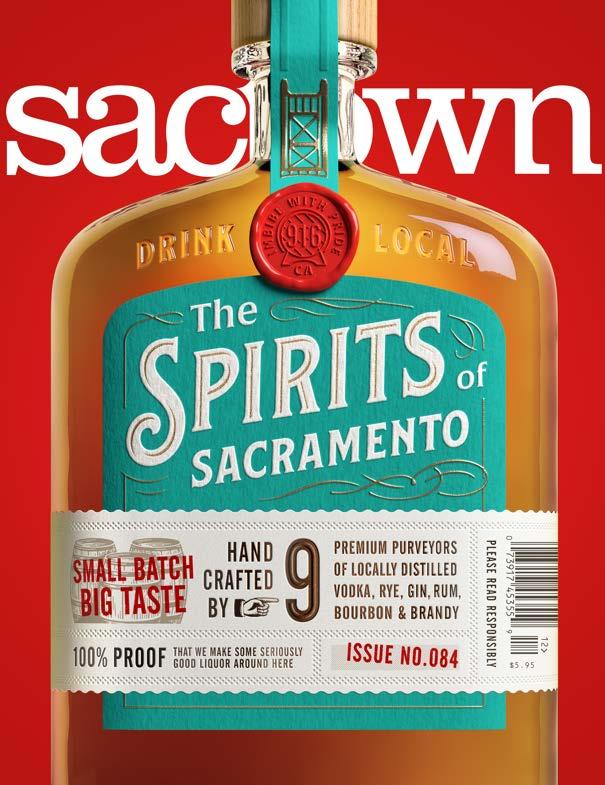
URBAN DESIGN
ON REDESIGNING THE STATE CAPITOL
FARM TO FLASK
COULD YOLO BECOME THE NEXT MEZCAL HOT SPOT?


BABES ICE CREAM & DONUTS DEBUTS

ON REDESIGNING THE STATE CAPITOL
COULD YOLO BECOME THE NEXT MEZCAL HOT SPOT?

Beautiful to look at and low maintenance, Ultra™ Series fiberglass windows and doors are built to last. Through a careful design process, Milgard introduces a window more resistant to heat, insects, and water damage to help withstand the harsher sides of Mother Nature. Available in four tough, durable exterior finishes, Milgard Ultra features a Full Lifetime Warranty with glass breakage coverage for complete peace of mind.
AVAILABLE FROM THESE FINE DEALERS:
Southgate Glass: Sacramento 6852 Franklin Blvd, Sacramento, CA 95823 (916) 476-8396 • southgateglass.com
Southgate Glass: Carmichael 2411 Walnut Ave, Carmichael, CA 95608 (916) 978-1041 • southgateglass.com
California Craftsman: Auburn 13555 Bowman Rd, Auburn, CA 95603 (530) 887-1857 • californiacraftsman.com
California Craftsman: Truckee 11197 Brockway Rd, Truckee, CA 96161 (530) 582-1822 • californiacraftsman.com




Small batch, big taste. We spotlight nine makers of locally distilled vodka, bourbon, rum, gin, rye, brandy, absinthe and more. Please read responsibly.


Page 12 Opening Shots
Local artist Brandon Gastinell pays visual tribute to Frida Kahlo during the 2020 Wide Open Walls mural festival; a NASA satellite captures a tremendous wall of smoke stemming from unprecedented California wildfires
Page 17 Riverfront
The Capitol faces an extreme makeover, and given the state of our econ-
omy, the timing couldn’t be worse. We think a public conversation is very much worth having; a Q&A with Megan Van Voorhis, Sacramento’s new Creative Economy Manager; Pushkin’s Bakery owners hit the sweet spot with Babes Ice Cream & Donuts; food truck Nash & Proper goes brick-and-mortar
Page 101 Play
Inspired by Lady Bird, psych-pop art-
For centuries, mezcal—the ancient intoxicant steeped in Mexican tradition—has sprouted almost exclusively from the vast agave farms south of our border. But one Yolo County hobbyist farmer believes that climate change, of all things, has the potential to spur a California version of the storied spirit to take root right here. And despite extraordinary odds, he might just get his day in the sun.
ist Anton Barbeau is back home (at least for the time being) after a long spell in Europe. He chronicles his own coming-of-age, leaving-the-nest story in a new double album and a nostalgic music video filled with classic Sacramento iconography.
Page 105 Dish
A next-gen Persian restaurant opens in midtown, serving up classics like saf-

ON THE COVER
ILLUSTRATION BY TILT DESIGN & BRANDING
fron-seasoned kebabs alongside newfangled Old Fashioneds infused with smoked tea leaves.
Page 120 Why Not Here?
In Tokyo, a renowned architect conjured up an elegant solution to a notso-elegant urban design challenge: public toilets. We should take the plunge on his creative idea to build restrooms with, yes, see-through walls.

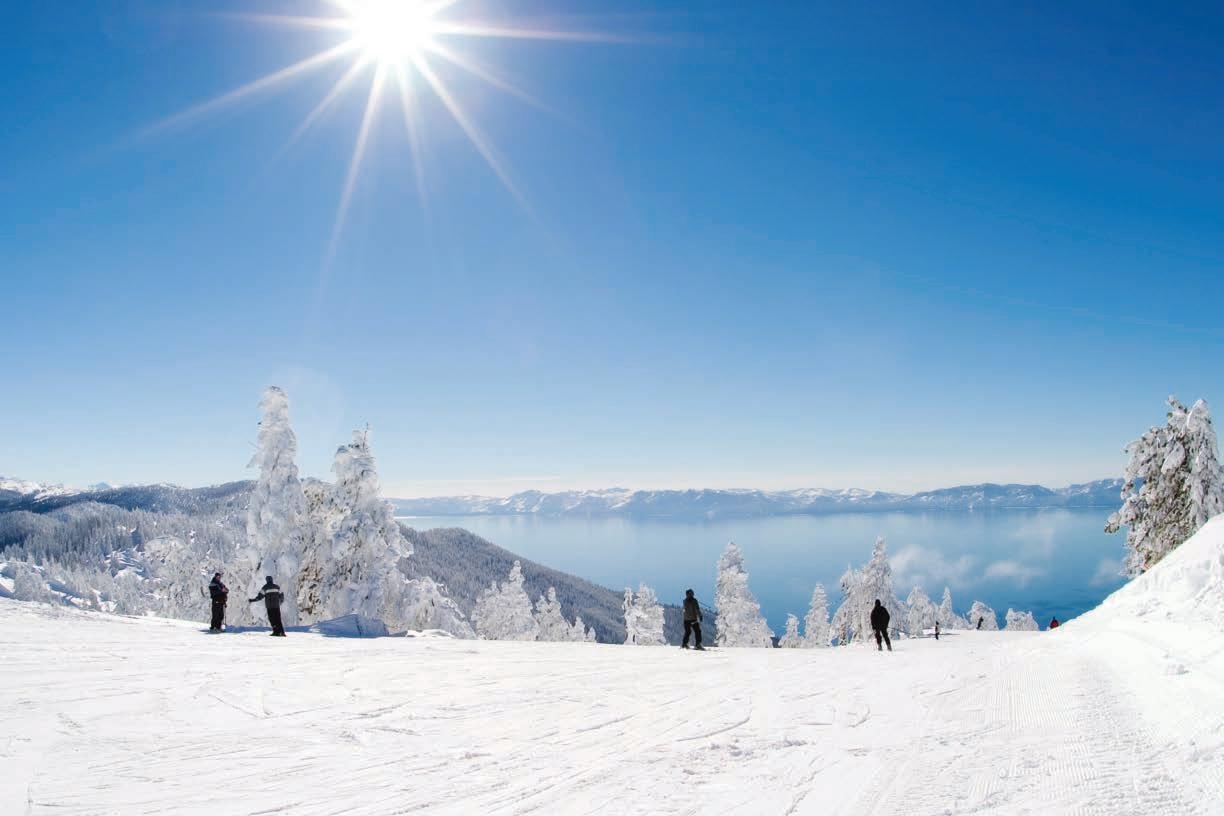















FOUNDERS AND EDITORS-IN-CHIEF ROB TURNER & ELYSSA LEE
SENIOR EDITOR
LEILANI MARIE LABONG
EDITOR-AT-LARGE
HILLARY LOUISE JOHNSON
ASSISTANT EDITOR JESSICA RINE











STAFF REPORTER CURTIS YEE
SENIOR CONTRIBUTING PHOTOGRAPHER MAX WHITTAKER
CONTRIBUTORS
JASON MALMBERG, JEREMY SYKES, STU VANAIRSDALE, ANDREW WARNER, ANNA WICK
EDITORIAL INTERNS BRANDON JETTER HANNAH ROSS
ADVERTISING DIRECTOR SCOTT HASSENFLU
SENIOR ACCOUNT EXECUTIVE TANIA MUSKOPF
BUSINESS OPERATIONS MANAGER LEAH GOSS







NEWSSTAND MANAGER JOE LUCA
RETAIL SALES MANAGER TOM SCHUSTER NATIONAL
METROPOLIS PUBLISHING, LLC 1107 9TH ST., SUITE 900 SACRAMENTO, CA 95814
Sactown magazine [ISSN#1932-622X] is published bimonthly at 1107 9th St., Ste. 900 Sacramento, CA 95814. Office: 916-441-4747
Subscription services: 866-616-6366 or subscriber@sactownmag.com.
Copyright © 2020 Metropolis Publishing, LLC, publishers of Sactown magazine. All rights reserved. Reproduction in whole or in part of any text, photograph or illustration without written permission of the publisher is strictly prohibited. Unsolicited manuscripts will not be returned unless accompanied by a stamped, self-addressed envelope. Annual subscription price $15 (6 issues), Canadian subscriptions $27 USD.
Postmaster: Send address changes to Sactown Magazine
Subscriber Services
1017 L Street #671 Sacramento, CA 95814

Now Open
Reconnect with your Academy favorites. From the clownfish in the aquarium to the wildflowers on the roof, the building is bursting with life. You’re invited to come explore.
Every visit supports our mission to explore, explain, and sustain life. Make your reservation and learn what we’re doing to keep you safe at calacademy.org.




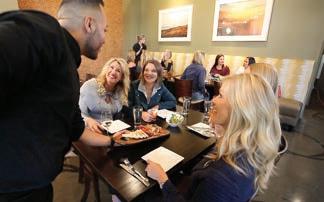




























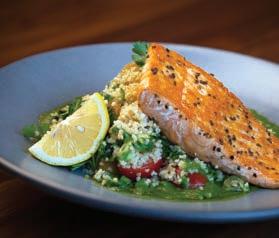




























































































































































































































































Sacramento artist Brandon Gastinell takes a break from creating his three-panel mural on Sept. 23 during the 2020 Wide Open Walls festival. Emblazoned on the east wall of Burgers & Brewhouse near 16th & J streets, the piece features portraits of 20th-century masters Frida Kahlo (shown), Andy Warhol and Jean-Michel Basquiat, a technicolor testimony to the importance of diversity in the art world and beyond.
PHOTOGRAPH BY
DANIEL JAMES


On Sept. 9, a massive wall of dense smoke— visible from 1 million miles above Earth—was captured by NASA’s Terra satellite smothering much of the Golden State and parts of Oregon. As of a month later, more than 4 million acres had burned in California in 2020, representing a new record for the number of acres burned in a single year. The previous record, set in 2018, was under 2 million acres.
IMAGE BY LAUREN DAUPHIN/NASA



Congratulations to all of the recipients of the Republic FC Kickstart program! Republic FC is proud to have partnered with Suncrest Bank to assist in their mission of continuing to support Sacramento’s economic recovery with over $10,000 in grants for local, blackowned small businesses.

A billion-dollar plan to demolish and rebuild the State Capitol annex, design an underground visitors center, and dig up part of our historic Capitol Park for an exclusive parking garage for legislators is at least partly ill-conceived and entirely ill-timed. But there is the potential to create something great, if we just invite more people into “the people’s house.” By Rob Turner First
Ken Cooley is on a mission.
On the late September afternoon that the Rancho Cordova assemblyman calls me to discuss his efforts in shepherding a billion-dollar plan to rebuild the Capitol annex, the large office building that was grafted onto the back of the historic State Capitol in the 1950s, he’s deep in campaign mode, driving around his district and personally offering up lawn signs as part of his upcoming reelection efforts.
He’s clearly a hands-on guy, and he’s doing his best to carry the baton of guiding the biggest State Capitol improvement project in nearly 70 years across the finish line. “I didn’t pick the endeavor—the endeavor picked me,” he says.
And he’s right. In 2017, when Cooley became chair of something called the Joint Rules Committee—15 senators and 15 assembly members who make decisions about the Capitol building—he inherited a plan launched under Arnold Schwarzenegger and funded under Jerry Brown, to de-
molish the annex and replace it with a modern version.
But Cooley is facing some very big hurdles these days.
And for all his good intentions—to build a safer, more efficient space for Capitol staffers—I think we need to throw a few more hurdles in the way of his committee, and here’s why.
The project is one of the biggest in Sacramento’s history, private or public. But the process, despite Cooley’s insistence to the contrary, has been cloaked in more secrecy than a project of this magnitude should be. This needs to be a more inclusive process. Not just because of its extraordinary cost; and not just because your tax dollars are paying for it; but because this is the Capitol of California—the physical and historical manifestation of our democracy.
It’s “the people’s house,” as Cooley himself frequently calls it, and the questions coming before the committee very soon—Cooley is aiming for November, and possibly as early as Nov. 5, he says—involve carving up part of Capitol Park
to install a private underground garage exclusively for legislators and senior staff; tearing down a historic annex designed by the architect of the Tower Bridge; and choosing a new design from a worldrenowned firm, but with little to no input from the public, or virtually anyone outside the committee.
And all this while the state faces a staggering $54 billion deficit due to the impact of Covid-19, as well as record wildfires; not to mention the uncertain future of office space and telecommuting.
But first, what exactly is this project and how did we get here?
In short, state legislators in the 1940s deemed that there wasn’t enough room in the original Capitol, completed in 1874, to house the people needed to manage the quickly growing state under one roof.
So, they ripped off much of the backside of the historic Capitol (including the lovely semicircular apse structure, pictured here) and constructed a six-story office building, known as the annex, on the east side of the building. The mid-century edifice was designed by noted architect Alfred Eichler—best known to Sacramentans as the designer of the iconic 1935 Tower Bridge on the western end of Capitol Mall.
It opened its doors in 1952.
Fast-forward to 2006, and to no one’s surprise, the building no longer met many modern safety requirements. There are, for example, no water sprinklers in the annex; there are accessibility issues for those with disabilities; the air-conditioning system is badly outdated and much more. In summary, it’s not nearly as safe and efficient as it needs to be. Everyone, even the project’s opponents, agrees on that part.
But here’s where the disagreements— and maybe the opportunities—begin.
And this is as good a place as any to introduce one of the leaders of the opposition, Dick Cowan—a construction expert who early in his career helped restore the gorgeous west wing of the State Capitol from 1977 to 1980, and who later served as the chair of the Historic State Capitol Commission.
Cowan makes the case that we’re only in this position because the Legislature hasn’t taken care of its own house.
“Whose responsibility has it been for 70 years to address code upgrades; to replace power systems; to increase HVAC capacity?” he asks. “For 70 years, they found it inconvenient to their calendar to do these major upgrades.”
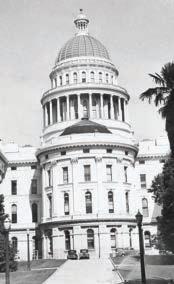
billions in surplus cash.
But then Covid-19 hit California in March, and everything changed.
By May, Gov. Newsom halted general fund expenditures, including those for the annex, due to the spiraling deficits.
But Cooley had a fail-safe plan: PreCovid, in anticipation of the possibility that some kind of budget shortfall could present itself at an inopportune time, he sought and secured the authority to fund the project through the sale of what are called “lease revenue bonds,” something he says today he hoped to avoid. “Personally, I hate the idea of bonding for the people’s house,” says Cooley. “Borrowing is never my favorite activity.”
And yet… that’s now the plan. “I’m going to be making use of a tool in the state government toolkit,” he says.
But there are at least two major flaws with this approach.
The first is that the state has a deficit that is growing by the day, and bonds aren’t free money; they still have to be paid back—in this case, by a state that will likely be hemorrhaging money for years.
The second is that the debt service on bonding significantly increases the overall cost. When I asked the state’s own Legislative Analyst’s Office about the economic impact of selling bonds to fund the $755 million project, they replied: “We estimate that the total costs for the project would likely total over $1 billion, with interest costs of a few hundred million.”
That last part bears repeating: “Interest costs of a few hundred million.”
In 2006, the Department of General Services (the entity that oversees and maintains most of the real estate holdings for the state) tapped the prestigious local architecture firm Dreyfuss & Blackford to complete a Capitol infrastructure study, assessing what it would cost to refurbish the Capitol—bringing deficiencies up to code along with other improvements.
The report concluded it would cost at least $200 million to renovate the existing annex, but at some point soon after, the state decided it was preferable or cheaper to tear it down and build from scratch.
He says there’s a name for this in the world of historic preservation: “demolition by neglect.” Owners who have neglected historic properties often argue that they need to tear them down because they’re not up to code even if they were the ones who didn’t make those upgrades throughout the life of the property.
Cowan, who owns a construction consulting company, believes the current annex could be refurbished for about $250 million today. Some other experts with direct knowledge of the project estimate $500 to $600 million.
Regardless, $755 million was appropriated for the project during the flush days of 2018 when the state was bursting with
On top of that, the state is currently constructing a second state office building a block away at 10th and O streets, dubbed “the swing space,” which the 1,250 Capitol staffers—from the governor on down—will move into later next year, and remain in until the new annex is completed in 2025. That building will then be used for other state agencies. That building is costing $424 million to construct.
That means we have moved from a $200-million-plus refurbishment estimate in 2006 to a nearly $1.5 billion total plan in 2020, just as multiple global crises are hitting our state particularly hard.
Talk about bad timing.
But this isn’t just about the money.
The most vocal public opposition so far has come from groups like the Sacramento






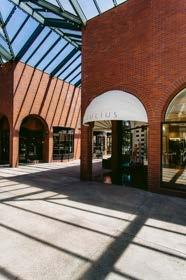


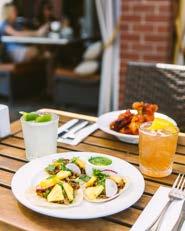
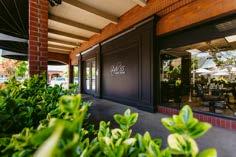
Tree Foundation, Preservation Sacramento, SacMod, the regional Sierra Club chapter, and other local and state preservation groups. Several Native American tribes are also very upset with the committee about the potential destruction of cultural resources.
And the most controversial aspect of the project in recent months has been the plan to dig up part of Capitol Park for the private underground garage for the legislators.
Cooley says it’s unsafe to place a new garage directly beneath the Capitol in a “post-9/11” world. So the proposed solution is to excavate a portion of the park—removing dozens of trees—and construct an underground garage away from the building. The garage would hold about 150 vehicles—just enough for all 120 legislators, the governor and other senior Capitol staffers.
For those not familiar with the site, Capitol Park is essentially a living museum, filled with trees that possess cultural or historical significance—trees planted in the 1800s; trees gifted to the state by other nations; trees that were transplanted here from the battlefields of the Civil War. One tree, a coast redwood nicknamed



the “Moon Tree,” sprouted from seeds that orbited the moon during the Apollo 14 mission in 1971.
According to the Historic State Capitol Commission, the park “contains species of plant life from nearly every part of the globe.”
The state estimates that approximately 30 trees will need to be removed to make room for the garage, though they say they are working closely with the park’s arborists and they hope that many can be saved and replanted.
Opponents believe that number is closer to 100 trees. And while the state argues that figure is far too high, it says that it still doesn’t know and can’t know the exact number of trees—or which ones will have to go—until the garage design is finalized this coming spring or summer.
If there are, in fact, historically significant trees at stake, waiting until plans are “finalized” strikes me as far too late in the process to be acceptable.
But if saving trees—even historic ones—doesn’t pull at your heartstrings, let’s focus on the money for a moment. Just how much will a new private underground parking garage for legislators and their senior staff cost?
Either no one knows or no one is saying.
I asked Assemblyman Cooley and he said he didn’t know and referred me to the facilities management director, but she didn’t know either, and said she didn’t know who would know.
But how can the cost of a major component of a billion-dollar project not be a known number at this advanced stage?
In 2017, the Michigan State Capitol Commission considered a 300-space underground garage for legislators and staff at a cost of $30 million. At the time, State Representative Larry Inman told a TV station, “I think that’s a luxury item. People see that state government is having challenges now funding various programs and services. I don’t want to go back to my district and explain $30 million for a parking structure.”
The Michigan garage wasn’t funded.
As for the argument that it’s not safe to have a garage under the State Capitol, the obvious question is: Why then has the current garage been operating, apparently unsafely, for nearly 30 years since the World Trade Center garage bombing in 1993? Or perhaps there have been no major incidents because there’s been a security checkpoint at the entrance to the Capitol garage to prevent an attack. Wouldn’t there be one with a new annex as well?
Or why not consider parking off-site? Many state capitols around the country don’t have underground garages.
In Phoenix, legislators park in an adjacent surface lot that doesn’t even have a security gate. In Colorado, pols also park in an outdoor surface lot. How about freezing Bismarck, North Dakota? Yep, an uncovered surface lot. In Carson City, Nevada, they park in an aboveground garage next door. In Boise, they use either a state-owned garage or surface parking lot—both across the street. In Madison, Wisconsin, they either park on the street or in a garage two blocks from the Capitol, says Molly Dillman Vidal of the Wisconsin Department of Administration.
Being that they’re in Wisconsin, I asked Vidal if perhaps they had underground tunnels for their two-block trek. “No underground tunnels!” she replied. “They just walk—even in the snow!”
In a city that boasts nearly 300 days of sunshine, a short stroll to the Capitol for Sacramento lawmakers doesn’t seem like much of a hardship (especially compared to those hardy senators in icy Bismarck and Madison). During his first term in the 1970s, Gov. Jerry Brown chose an apartment on N Street so he could walk to


When local mom Amanda discovered she was pregnant with triplets, she turned to the region’s only nationally ranked level IV newborn ICU. After you choose a health plan, remember to also choose personalized primary care and world-class specialty care at UC Davis Health. Discovering healthy has never been easier, with 17 local clinics that bring life-changing health care to your front door.
17 clinics in 10 communities | 150 specialties | Routine check-ups to breakthrough surgery
Ready to be dazzled?
This holiday season, downtown Sacramento businesses are transforming their storefronts with festive displays for all to enjoy. Experience downtown come alive with holiday cheer!
your holiday stroll at: GoDowntownSac.com


work. In his most recent term, he was even known to occasionally hoof it the seven blocks from his apartment at 16th and J streets to the Capitol at 11th and L.
And if the legs of our current crop of legislators tire more easily than those of the then-septuagenarian governor, perhaps the state should consider leasing 150 spaces in the parking structure directly across the street from the Capitol at 10th and L. Owned by the city of Sacramento, it happens to be named “Capitol Garage.”
But here’s the ultimate irony: The state is already planning for the future underground garage’s obsolescence.
In the state’s own plans, it says, “the new annex parking would be designed for maximum flexibility and convertibility to meeting space versus parking if needed in the future. For example, the floor-to-ceiling height would be such that the space can meet building codes for a use other than parking.” When I asked Cooley about that, he said, “I think that makes sense because long-term, who knows what roles car will play?”
Exactly.

At a time when Gov. Newsom is issuing dire warnings about climate change, and calling for a ban on new gas-powered cars by 2035, the last thing the Legislature should be doing is tearing down a bunch of historic trees, and spending untold millions (quite literally untold) to make room for
, people. Where’s the innovation? Where’s the emphasis on trees over cars? Where’s the big-picture thinking?
As for the visitors center, Cooley says that part of the project has been “paused” due to funding issues. And that’s a good thing.
But here’s where the Joint Rules Committee’s lack of transparency on the annex provides a huge missed opportunity.
In the committee’s Sept. 9 hearing, the members were supposed to vote to approve a direction for the project, selecting from one of three radically different designs for the annex. They were presented by Skidmore, Owings & Merrill (SOM)—a worldrenowned firm known for, among other projects, the new World Trade Center tower in New York—and include an intriguing circular concept that echoes the Apple campus in Cupertino. The Sept. 9 vote would have set the design wheels in motion.
But the members were only shown the , and were then going








to be asked to vote on which design to move forward on only 24 hours later, after a short presentation from the architects.
How can anyone—let alone lawmakers untrained in architectural design—make a selection for a building designed to last generations with only one day’s notice? And why aren’t design advisory boards in place—as there are in most cities—to help the members make an informed decision? When it comes to California’s signature building, form should certainly be considered alongside function.
Further, Assemblyman Cooley should invite the eager members of the Historic State Capitol Commission to participate in these discussions as well. The commission was, ironically, created by the Joint Rules Committee for this very purpose. But the commission members, who care deeply about the historical integrity of the Capitol, have been sidelined throughout this process, a fact Cooley acknowledges when he says their participation is “not a mandatory consultation role.”
With all due respect to Assemblyman Cooley, if he truly wants the people’s house to represent “the people,” it’s critical to invite more knowledgeable, passionate citizens into this process, especially to consult on the historical and design implications of the committee’s decisions on these issues.


The only reason the committee didn’t vote on Sept. 9 was because not enough members showed up to establish a quorum. And thank goodness for that.
Assemblyman Cooley frequently cites how “public” and “transparent” this process has been. “I actually think you would be hard-pressed to find a project of this magnitude that has been as public as this project for years,” he told me. Dick Cowan, in turn, calls this endeavor “the most secretive public project I’ve ever been associated with, and I’ve been associated with a lot.”
It’s hard not to agree with Cowan on this point.
While Cooley cites how the annex project’s website has been updated frequently since it was launched in 2017, which may be true, I guarantee that few people in California even know this site exists. And a handful of local articles over the years—because that’s all there is—doesn’t make this project a visible one.
But it’s not just a matter of transparency.
You see, the state of California can build whatever it wants, whenever it wants. Even though it’s in the heart of downtown, the city’s planners, leaders and citizens have


Integrity: We recognize that customers want to do business with a company they can trust.
Transparency: When you work with ZOOM, we strive to be open, frank and candid with you and our employees. We don’t have anything to hide!
Service: Our tenured expertise is unparalleled, and service is top notch. Let us show you!
Dependability: When you have a need, ZOOM will take care of it. Simple as that.
Commitment: ZOOM is committed to taking care of our customers and our employees. Without either of them, there would be no ZOOM!
There are duplicates out there…but there is only one ZOOM.
916.369.6526 zoomcopiers.com








little to no say in the project. Maddeningly, the state is exempt from all local design regulations. So we’re largely helpless spectators when it comes to state projects.
If the state wanted the new annex to look like the black monolith from 2001: A Space Odyssey, it could build a 100-story version of it in the middle of Capitol Park, and there’s nothing you or I could do about it.
Except, perhaps—and that’s a big perhaps—if we make enough noise. Sometimes that works. And that’s what should happen right now. Because Assemblyman Cooley—who I do believe wants this to be a great project—plans to reconvene his committee soon and vote to move forward on a project that the public knows largely nothing about, at a time when the state is deeply underfunded.
Look, SOM is one of the best firms out there, and if we do end up building a new annex, they’d be on anyone’s short list.
But simply put, now is the time to hit the pause button on this entire project.
Right now, we have a $54 billion deficit in California due to Covid-19, and that was before the historically devastating wildfires.
Right now, the pandemic has prompted a complete rethinking of how offices—including state offices—will function.
Right now, the future of telecommuting is completely unknown. In late September, Gov. Newsom said he wants to explore the possibility of 75% of state workers telecommuting after the pandemic ends.
And the governor is rightly more focused on climate change than ever, and on reducing our reliance on automobiles.
Yes, we need to fix every dangerous issue with the existing annex, and yes, maybe we need to start the conversation on what a replacement might look like. And perhaps a visitors center, done right, has the potential to be a new civic amenity for Sacramento and an educational tool for California.
Maybe. But now isn’t the time.
Instead, now is the time to truly engage the public, and begin the conversation that’s been happening behind closed doors.
As for the right time to discuss tearing down historic trees for a private parking garage for legislators? To paraphrase the classic New Yorker cartoon, “How about never? Is never good for you?”
The only green spaces that our legislators should be disrupting right now are the front yards where they’re placing lawn signs for their reelection campaigns. And even then, we hope they’re getting some buy-in from the owners of those houses first. S




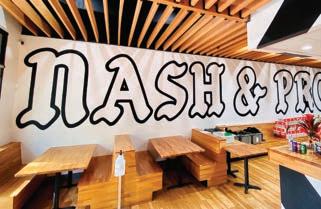

In hot pursuit of a Nash & Proper spicy chicken sandwich? Just follow the heat to the buzzy mobile eatery’s first brick-and-mortar shop
Since hitting the streets in 2018, the food truck Nash & Proper has been going full throttle, hawking its Nashville hot chicken sandwich at festivals and farmers’ markets all over Sacramento. Two years later, after winning Downtown Sacramento Partnership’s 2019 Calling All Dreamers contest, chef-owners Jake Bombard and Cecil Rhodes II (pictured above, left to right) have expanded their fleet and opened a brick-and-mortar version of their fourwheeled sensation in September. The location: a storefront on K Street last occupied by popular vegetarian eatery Mother, a cosmic irony for a carnivore-centric establishment.
The new setting—emblazoned with wall murals designed by Magno Lopez and painted by Jeremy Stanger, including one of a fire-breathing chicken—may be different, but the long lines for N&P’s Instagram-famous sandwich are the same. Each boneless chicken thigh for the signature dish is double-dredged in egg wash and seasoned flour before it’s deep-fried to an extra crunchy
crisp. Then, a choose-your-own-adventure moment: Will you order your fried chicken “naked” or risk one of four increasingly fiery oil dips, from mild (made with cayenne) to “cluckin’ hot” (a Carolina Reaper-flavored plunge)? Whichever path you take, all roads are paved with a baseline of bite—toppings include a pickled jalapeño slaw and a spicy mayo “fuego” sauce slathered on a brioche bun.
Other menu standouts—such as the deep-fried cauliflower florets or fried-chicken-topped Proper Fries—can also be spiced to your desired heat level. But if you think you’ll conquer the most incendiary tier with taste buds unscathed, think again. Many of the uninitiated have found themselves begging for an ice-cold bottle of King Cong Brewing IPA to dampen the inferno. “First-timers always think they can handle the spice,” says Rhodes, chuckling. Consider yourself warned. 1023 K St. nashandproper.com —Curtis Yee

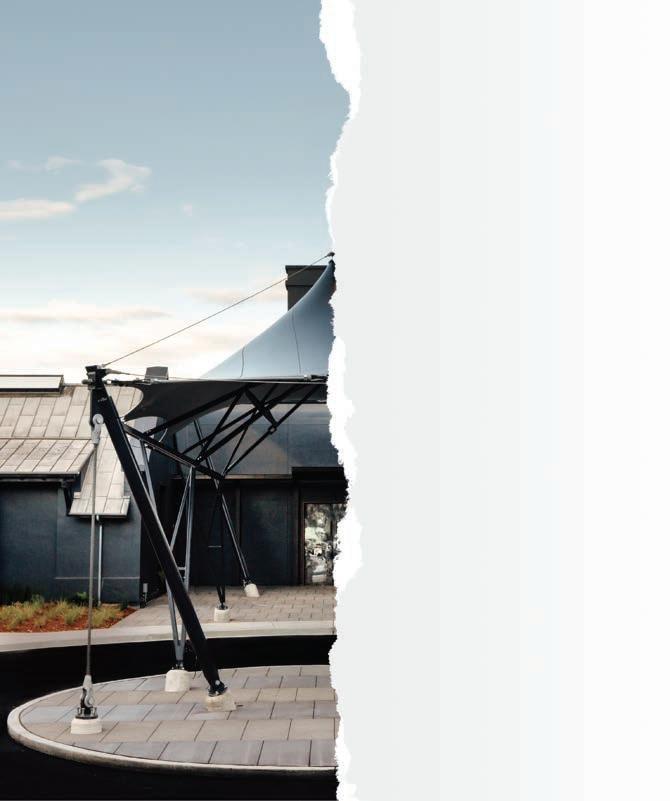

You are looking ahead, investing wisely, being extra smart with your money. We know because it’s our business to know. This is why we are proud to offer surcharge-free ATMs at over 30,000 locations, easy access to your funds through our APP, and a group of employees with one goal in mind - to always put YOU first.
Visit joinSAFEtoday.org to learn why our credit union is right for you.



Gluten-free gurus Danny and Olga Turner of Pushkin’s Bakery launch a new desserterie
At midtown’s Babes Ice Cream & Donuts, the latest from Pushkin’s Bakery owners Danny and Olga Turner, two classic cravings can be satisfied at once, with an allergy-friendly twist: The titular confections are all vegan and sans gluten. While Danny’s doughnuts—from his favorite, a fritter studded with hand-diced Granny Smiths, to Olga’s go-to chocolate sprinkle—are a Pushkin’s mainstay (even Babes’ mascot, a French bulldog, eyes one in the shop’s mural), scoops are new territory. Olga’s rich coconutmilk recipe churns out lusty, dairy-free flavors, from the popular pistachio to the decadent chocolate peanut butter fudge and tart orange creamsicle, swirling with nostalgia. “You’re not missing anything with this ice cream,” says Olga. “It’s so stinkin’ good.” 2417 J St. babesicecreamdonuts.com —Jessica Rine


Discover the path to your future. Whether you see yourself as a nurse, physician assistant, family nurse practitioner or researcher, the Betty Irene Moore School of Nursing at UC Davis is ready for you. Ranked among the nation’s top 50 nursing schools by U.S. News & World Report, our programs go beyond clinical education to elevate your ability, confidence and dream to be a new type of health care leader.
With state-of-the-art facilities located on the UC Davis Sacramento campus, you’ll experience hands-on learning, high-tech simulation training, and the best educators who partner with you for your success. Take the next step so you can achieve your dreams.
Our graduate programs:
■ Doctor of Philosophy
■ Master of Health Services — Physician Assistant Studies
■ Master of Science — Family Nurse Practitioner
■ Master’s Entry Program in Nursing
■ Graduate Academic Certificate Program for Health Professions Educators
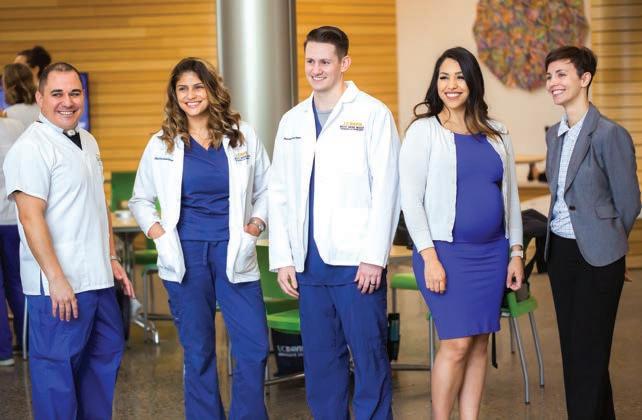













The Betty Irene Moore School of Nursing at UC Davis is the only graduate school created to activate change where it is needed most. We go beyond clinical education with programs that elevate the ability, confidence and vision of a new type of health care leader. We need nurses like you—professionals who seek a greater impact in health—those who believe in better.
Why you should choose Betty Irene Moore School of Nursing at UC Davis:
• Emphasis on leadership
• Dedication to inclusiveness
• Leader in simulation learning
Learn more at nursing.ucdavis.edu.




• State-of-the-art facilities
• School-coordinated clinical placements
• No GRE or GMAT required
Ph.D. Program (Four years)
The full-time doctoral program prepares you to lead in health care, health policy, and education and research at the university level. Your future career path could be in research, education, government organizations or health administration.
Build a strong foundation for a brighter future. Our master’s-degree FNP program prepares you to lead diverse teams and improve health care in communities where it’s needed the most. Our faculty at the Betty Irene Moore School of Nursing at UC Davis invest in your success so you can become a nurse leader.
Certificate
(Three quarters concurrent with degree program)
Graduate nursing students with an interest in education may apply for this certificate program to prepare to teach in prelicensure nursing and other health professions programs. Graduates are eligible to apply for Certification for Nurse Educators.
In a year of challenge, it’s easy to feel stuck. While it might seem easier to press pause on your future, we’re here to tell you the future at William Jessup University is brighter than ever. You’ve put so much of your life on hold. Make this the semester you jump in. Unpause your education and press play on your future.
As a nationally-ranked Christian university, Jessup has more than 70 programs on campus and online. We maintain high academic standards while guiding students towards fulfilling careers and authentic relationships with Christ.
Take back your future with a Christ-centered, communityfocused, and career-ready education from Jessup.
Christ-centered Higher Education EST. 1939 | JESSUP.EDU

Why choose William Jessup University?
Expert faculty who know you by name
Christ-centered higher education
Diverse and comprehensive academic programs
State-of-the-art classrooms
No.1 Top Performer in Social Mobility*
No. 2 college in Regional Colleges West*
No. 2 Best Colleges for Veterans*
No. 4 Best Value Schools*
Traditional undergraduate programs
Adult degree completion with flexible schedules
Master’s programs
*As ranked by U.S. News & World Report’s Best Colleges in the Regional West
Unpause your future at a Christ-centered university offering degrees through traditional, continuing and online platforms.

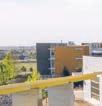






Jessup is open and the future looks bright. With more than 70 degree programs, students can choose from a variety of concentrations and specializations.
Opportunity Awaits
• Programs built around a solid liberal arts core
• Mentorship and academic curriculum foster spiritual development
• Affordable, flexible and convenient







• Internships and work preparedness course opportunities
• Lifelong educational support services
• A Yellow Ribbon school
Learn more at jessup.edu

Jessup offers undergraduate degrees that prepare you for a rewarding career or continuing on to graduate school. Our liberal arts curriculum, founded on the integration of faith and academia, prepares you for leadership in your chosen field.
Jessup’s graduate programs are structured for the working student. Whether you’re juggling career, family, volunteer opportunities, or all of the above, our programs fi t around your busy schedule. Our master’s programs are designed to prepare you to be a highly competent, principled and innovative leader.
Discover your purpose and reach your goals by earning a flexible and affordable online degree at Jessup. We offer professional programs with personalized academic support in a faith-based environment. Choose from multiple start dates throughout the year to fit your busy schedule.




Growing up in Flint, Michigan, Megan Van Voorhis wanted to be a ballerina like the one she saw twirling on an episode of Sesame Street. It wasn’t until she took a business administration class in college that she realized her calling wasn’t to make art, but to make art possible. As the head of Arts Cleveland, she introduced innovative programs linking art with health care and helping creators access their inner entrepreneurs. As Sacramento’s freshly appointed Cultural and Creative Economy Manager, the former dancer takes the stage for her next act. Here the new 916 resident talks about the arts’ influence on the GDP, how to reopen venues safely in the age of Covid, and why the ability to create is a basic human right.
by Hillary Louise Johnson

Tell us a little bit about Arts Cleveland, where you spent nearly 20 years—most recently in the position of president and CEO—before moving to Sacramento in September. Arts Cleveland is an organization that carries out advocacy work on behalf of the arts and cultural sector in Cuyahoga County, and provides direct service to the
“The public art here is fascinating. There are a lot of dynamics in terms of how you fuse national and international work and connect it to a local scene. It’s definitely something that I see, and that is hugely exciting.”
arts and culture community—counseling to individual artists and organizations on program development, strategic planning, business development.
I’ll give you an example: Archie Green is a hip-hop artist who suffered from depression for some period of time. We provided a lot of counseling to Archie and served as his fiscal sponsor. That allowed him to start doing mental health work in Cleveland, understanding that in the Black community there’s stigma around mental health and around bipolar
disorder. He’s starting his own nonprofit now. His organization is called Peel Dem Layers Back, which came from a song he [wrote] that was about coming to terms with his depression. He does shows that [combine] hip-hop and conversations with people in the mental health community to try to reduce that stigma associated with getting help.
Your new title is Cultural and Creative Economy Manager. What is the creative economy and why is it important?

‘Tis the Season for Traditional French Desserts
7:00AM-6:30PM
7:30AM-7:00PM
We’re now open until 8:00 PM on FRI SAT at both locations !
This is where data is really helpful. People care about the economy, and the creative economy itself is 4.5% of the GDP in this country. It’s bigger than agriculture, numbers-wise. The creative economy encompasses a lot if you look at it from a workforce perspective. There’s creative production happening through various vehicles. It could be an individual artist, a collective, a for-profit business or a nonprofit. You have the creative industries you might traditionally think of: theaters, music venues, art galleries, museums, cultural attractions. In addition to that, there are designers, industrial designers, graphic designers, fashion designers, architects, event producers, filmmakers and animators. It also impacts other parts of the economy—restaurants, travel and tourism. Then you also have creative workers who are working in other industries, like a graphic designer who works for a health care company.
Follow us on Instagram for more delicious updates: @
I’ll be working to bring to life the [city’s] Creative Edge plan, which got adopted in 2018 and has a specific focus on developing the creative economy. Part of my role is figuring out what to elevate from that plan right now, to prioritize where we want to focus in light of Covid-19.
In fact, at Arts Cleveland you helped set up an emergency fund for artists affected by the pandemic.
Most artists are packaging together a living three or four different ways. They’re teaching lessons, they’re gigging, they might be adjuncts at a university, they might be making their own work. My brother is a musician and a K-8 music educator in a charter school. So for artists in particular, it’s really hard now.
We went to the NoteWorthy Federal Credit Union—which is focused on filling the gap in creative capital and got its start doing musical instrument loans—and said, “What can we do to get access to capital for artists?” We ended up doing an emergency loan fund where the interest was subsidized by [a local] family foundation.
What is Sacramento doing on that front? I think Mayor Steinberg is leading the way in having chosen to invest in creative assets at this time, using funds that Sacramento got from the Feds. The team is doing an outstanding job of getting those dollars out [through the city’s Creative Economy Recovery Grants]. The total allocation was $14.4 million.
This year is anything but normal. As we juggle family and work, and keeping those we love safe, there is one thing we know for certain: Our health has never been more important. That’s why having a health care team you depend on means everything. At Dignity Health, we take pride in establishing long-lasting, trusted relationships with our patients. And, while we’re always focused on meeting their needs, in these unprecedented times, we’re more committed than ever.
So this year during Open Enrollment, make sure you’re getting the most out of your relationship with your doctor. Choose a health plan that connects you to Dignity Health hospitals and our affiliated doctors—such as Anthem Blue Cross, Blue Shield and Western Health Advantage. For a complete list of insurances accepted, and our affiliated medical groups and doctors, visit DignityHealth.org/OpenEnrollment

Arts funding can be considered controversial at a time when basic needs aren’t being met. What is your response to critics who don’t think government funds should be going to the arts?
I think it’s a very limited view, the idea that the arts are a luxury. First and foremost, creative vitality is critical. The United Nations actually considers the ability to create a basic human right.
The connection between arts and mental health is really strong. Cuyahoga County’s central hospital system, MetroHealth,
Anchored in the heart of Elk Grove, 56 acres are newly designed to inspire celebration and warm memories. A place to gather with the ones you love most. Just 15 minutes from California’s capital and a world away from ordinary, it blends sophisticated modern facilities with outdoor spaces that honor art and nature. The Center at District56 is a space you’ll want to experience and share on your special day.
has a project called SAFE—it stands for Students Are Free to Express. The objective emerged because of what they were seeing, that childhood experiences are a key predictor of whole student health. They’re helping kindergarteners understand emotion using the arts. Maybe it’s spoken word, maybe it’s making your own portrait. The program is a preventative measure to try to help them establish these healthy skills, not just as a response to trauma. There was a kid who participated in it and later at home saw her mother feeling sad and was able




to articulate her feelings and say, “Why are you feeling that way?” Establishing these skills very early on is so critical when you think about mental health. There is a strong interest in seeing that sort of thing happen here in Sacramento.
During the pandemic, you’ve also held regular conference calls with artists to brainstorm ideas for ways to respond to the situation. Any creative outcomes from that effort?
The [online marketplace] Made Cleveland was something that got introduced through one of those monthly artist calls. It was started by an artist who had a desire to help people bring their work to market and build capacity without having to set up their own websites. It’s a great example of the kind of thing that’s really needed everywhere. Developing new models and new ways for people to be able to engage with crafts and other creative products is really important.
The reality is that folks are hurting. But they’re also innovating. I got a tweet from a Sacramento Ballet dancer who’s involved with the Capital Dance Project, and they’re doing such cool stuff on film. [For a recent digital series] they worked with a filmmaker and performed on-site around Sacramento. Some of their videos are really amazing. If you think creatively going into this, you’re going to see this as a moment to innovate. It’s a tough time, but it’s also an opportunity to move things forward.
What are some other areas of opportunity that you see for Sacramento?
Housing. One of the things that Cleveland has is a low cost of living. I had been working with an organization in the Collinwood neighborhood there to think about ways to do co-ops or collective ownership to provide affordable spaces. Out here, the costs are so high. How do artists afford to live here? If you want to have creative vitality, then the conditions facing your creative people become really important. If artists can get access to better things elsewhere, do we lose that talent? That’s a real challenge right now in the arts industry.
Another real challenge is tackling racial disparities in the arts world. What are your plans to address this issue? A lot of us who work in this space are really just beginning to understand and bol-
Step aboard the River Fox Train and take off on an adventure inspired by the magic of the holidays! The Christmas Train is a seasonal experience kids of all ages look forward to each year and one you don’t want to miss. Seating may be limited, so book your tickets now to make sure you and your family get to attend this wonderful holiday tradition. Please visit our website for ticket pricing and more detailed information.


ster our own knowledge about what the history of America actually looks like. For me, growing up in Flint, I didn’t really get that education. I’ve done a lot of learning on racial equity in the arts and there’s still more to learn.
I can’t speak for a person of color, I’ve not had that experience, but at the same time, you can recognize the racialized dynamics. For example, how did the practice of redlining impact schools and segregation, and then how did that impact the resources and who has access to arts education programming?
Right now we have some demographic data we’re able to unpack: Arts Cleveland invested something like $3 million in 160 artists over an eight-year period, and it was a blind adjudication process—everything is stripped away, you don’t have resumes, you don’t have names, only the work. Despite those efforts, 71% of those artists were white. And we know that’s just not reflective of our population. When you apply a blind adjudication process on a racist system, you’re not going to get the kind of outcome that you’re looking for. So I think that self-study is really important,
and then adjusting practice based on that. There’s a responsibility that we have for surfacing the disparities, and then using that information to try to recruit folks who are not being supported.
What are your thoughts on the thorny issue of reopening performance venues? I’ll be honest. It’s going to take some time for people to feel comfortable going out. I’ve been actively involved with the efforts—with NIVA [National Independent Venue Association] and with Music Cities Together—to reopen venues safely. People performing over multiple nights instead of one night, queuing apps for getting people in and out, things like that. Smaller [organizations] could program in larger venues, so you’re putting 300 people in a much larger space that allows you to socially distance. And drive-in concerts— drive-ins were petering out, and I think it’s a great time to bring those back to life.
In your initial explorations of Sacramento, are there things that have stood out to you—any artists or experiences? The public art here is fascinating. There
are a lot of dynamics in terms of how you fuse national and international work and connect it to a local scene. It’s definitely something that I see, and that is hugely exciting. And I’m very interested in uncovering the stuff that people aren’t talking about. I am going to be on a search for the city’s arts and cultural soul. It’s going to take some time to figure out because some of it is very visible and some of it is not.
I chose to live near midtown. My family drove around lots of different areas and the midtown vibe was really great. The walkability is just amazing, the restaurants—it’s all there. My youngest son, who is 12, plays electric guitar and bass, and has very much an interest in wanting to stay in the midtown area. My oldest, who is a high school junior, has an interest in biomedical engineering, so we decided to check out UC Davis, and when we went to the engineering quad, what stood out to me was that there was a design, art, craft facility right next to it. It was pretty cool because there’s a really strong connection between engineering and design. I was like, “Damn, you guys get it!” S


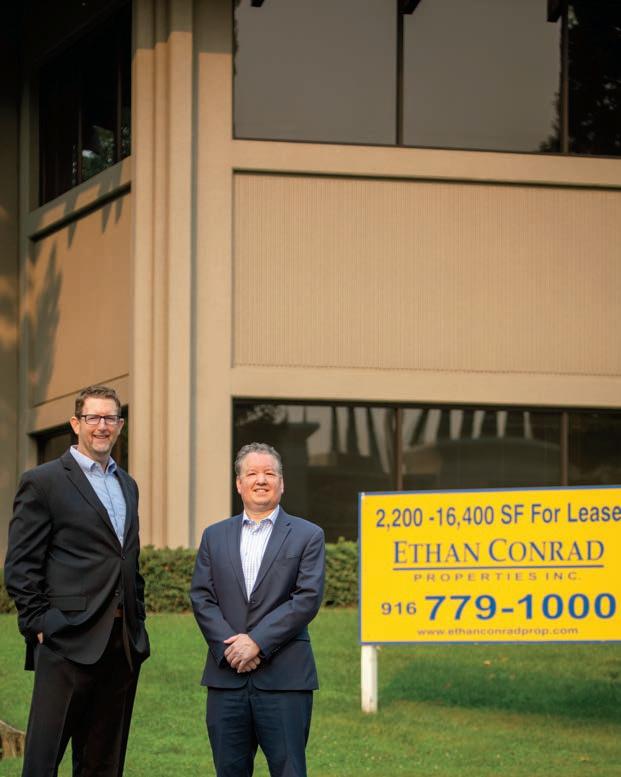

There is a myriad of rules in California that govern how certain properties dispose of certain materials. From traditional recycling of cans and bottles to the proper disposal of food scraps and food-soiled paper, keeping track of those rules to keep your property in compliance, and making sure you have the right equipment to get it done, is a full-time job.


Working together, Ethan Conrad Properties and Waste Management are finding cost-saving solutions and making Sacramento and California greener in the process.
“Making sure you properly dispose of materials can be very intimidating and confusing, especially when you have more than 1,600 tenants at more than 200 properties,” said Ross Tolbert, Director of Property Management at Ethan Conrad Properties. “That’s why we teamed up with Waste Management. They know the rules inside and out and can help make sure we are being the best stewards for our tenants and the environment.”
Ethan Conrad Properties prides itself on being a leader in the commercial real estate industry with a stellar reputation that helped make it one of the most recognizable commercial landlord names in the Sacramento area.


The company’s reputation is born from its commitment to excellence and pride in the buildings it owns and manages. Ethan Conrad Properties understands the importance of keeping properties clean, functional and an

Sacramento’s Largest Commercial Property Management Firm Works with Nation’s Largest Recycler to Get the Job Done.
asset to the neighborhoods in which they are located. It’s the reason the company chose Waste Management as its hauler.
“Waste Management provides an integral service to Ethan Conrad Properties and their many tenants, helping to ensure clean, pristine grounds which are free of debris or hazardous materials,” Tolbert said. “They help us properly dispose of everything from light blubs to food-soiled paper and help educate our tenants to do the same. We no longer have to worry about it.”


Erik Jorgensen, Manager of Sales for Waste Management’s Sacramento area, said the company has devoted numerous resources to help customers comply with state regulations and maintain compliance as those regulations become more stringent. From personal attention from a dedicated sales team member to friendly, safe collection drivers, Waste Management is a comprehensive environmental services provider that is prepared today and for tomorrow.
“Our goal is making the customer’s experience simple and worry-free,” Jorgensen said. “We’re a one-stop shop for all your disposal needs and can help you reach compliance, maximize your service value all while helping to keep your property and Sacramento clean.”


For more information about Waste Management services, please call: 866-844-1508






























If home is where the hearth is, ’tis the season to… spruce it up! Turn the page for a spirited holiday guide.

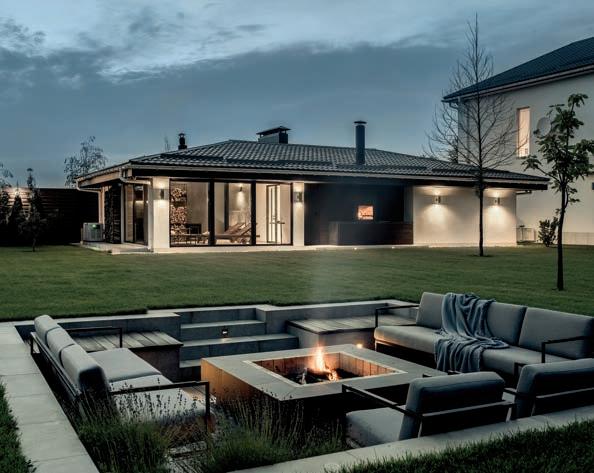
As we nest this winter, the coolest backyards are getting a warm reception
Now that cold weather is upon us, our hibernation instincts are steering us indoors. Still, fresh air almost always does a body good, and you don’t even have to go far—bundling up for an al fresco hot chocolate in your backyard will do the headclearing, immune-boosting trick. But why not make that outdoor space as cozy as it feels inside, complete with a roaring fire? Here are a few easy ways to warm up outside this winter.
It’s true that people—especially shivering people— are like moths to flame when it comes to outdoor fire pits, so consider this backyard feature a social hot spot for your quarantine crew. The city’s got a
ban on wood burning, so portable propane-fueled units are the elements of choice since they’re both smokeless (clean air, check!) and emberless (a safety consideration), and they don’t require a tedious gas hookup. Fire tables made of CorTen steel, concrete or even teak also function as attractive patio furniture, which means they’ve usually got a wide ledge around the pit to place drinks or snacks. All that’s required is a propane tank (some fire tables come with matching storage to cloak the unsightly vessel) and some common sense (check for leaks often and don’t even think about lighting a match in close proximity).









When most people consider replacing their windows or doors, they assume it will be stressful, time-consuming, and not the least bit enjoyable. But it doesn’t have to be that way.
Just download our easy-to-follow guide to learn about:
• When to replace versus repair
• What pes of windows and doors to consider
• What goes into a quote
• How to prepare for installation


























Even without the benefit of a fire, you can still stay warm in your backyard with heated patio furniture, though the combination of both would




certainly defy any bracing outdoor temperatures. Suddenly, winter stargazing is no longer limited by how long you can stand the cold, and cozying up with a good book is no longer considered an indoor activity when the mercury takes a dive. That said, you may need some light to read by. Since the days are short and the nights are long, a no-fuss way to draw the family outside beyond sunset is to hang up a charming string of Edison bulbs or place solar lanterns around the patio—the soft, orb-like glow can be a beacon for backyard enjoyment in any season, but in winter, it signals a wonderland.




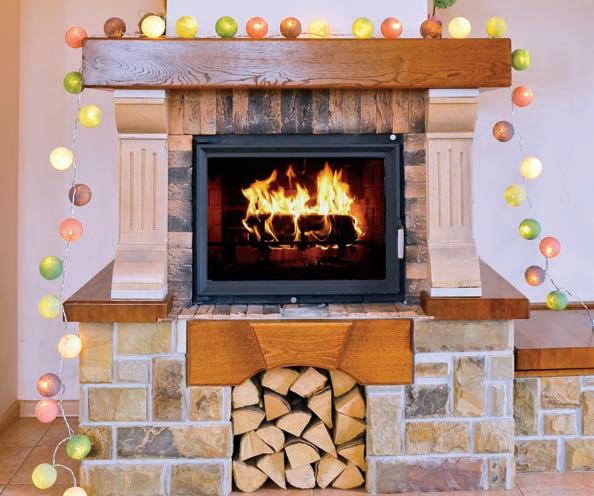
As the temperatures drop, bring the outdoors indoors to heat up your holidays
Even though festive gatherings may not be in the cards for the pandemic, the holiday spirit has a way of triumphing despite the odds. ’Tis the season for a few easy home flourishes that will spark a celebratory mood, which is a gift that keeps on giving.
• Bring the forest in. A fresh, evergreen fragrance always signals the holiday season, but don’t stop with the blue spruce Christmas tree. Live pine boughs trimmed with velvet bows, small bells or extra tree ornaments can wrap around a stair banister or embellish a fireplace mantle.
And don’t forget the ultimate sign of yuletide warmth and welcome—the wreath. These days, they aren’t just evergreen, either—eucalyptus and rosemary both have holiday plant essentials: a piney perfume and a verdant hue.
• Stick to a theme. Since this time of year can be a feast for the senses, consider a tonal color scheme or a single pattern for the tree and home décor—the effect ties together different parts of the house in a fashionable way. For example, turtledove ornaments, iridescent











































tinsel and white string lights evoke a frosty fantasy; while buffalo plaid wrapping paper and checkered pajamas for the whole family would make for a rustic, if not eye-boggling, Christmas morning.










• Light a fire. While older Sacramento homes have woodburning fireplaces, newer gas models light up with the flip of a switch, a low-maintenance way to get warm. (If you have the former, going through a safety checklist that includes having the chimney swept and ensuring that the damper is open will go a long way to keeping the holiday fun fiascofree.) Fireplaces tend to inspire a sense of comfort and family— the reason why they say home is where the hearth is.











Looking for an easy way to perk up the premises? Here’s our paint-by-numbers guide
In an ordinary year, holiday guests on approach may be incentive enough to apply some light home improvements to your residence. With the pandemic still looming, a quiet household may be just the motivation you need to whittle down your list of long-awaited enhancements. Here are a few ideas that are both easy and cost-effective, yet go a long way toward increasing the market value of your home.
According to USA Today, refreshing your home with a new coat of paint inside and out is bound to increase property values, but the actual colors have a lot to do with just how much of a dollar spike you can expect. For example, homes with sunny yellow kitchens and terracotta-hued exteriors have been selling for less than expected. On the other hand, natural shades are proving popular—they make the spaces appear classic in
design, but also larger in size. Bathrooms in calming shades of light blue could drive up the selling price $5,000 or more, while gray and oatmeal hues for the kitchen could add closer to $2,000. Don’t forget the front door—according to Zillow, a black front door to offset the light or neutral exterior paint could raise the selling price more than $6,000.
Another easy project is a great hardware swap-out. Vintage door handles and cabinet pulls are the exception, especially if they’re original to the house. But for the most part, paintchipped or plastic hardware won’t do your home value any favors. The crisp lines of modern houses tend to favor shiny chrome fixtures, while the warmth and built-in patina of oiled bronze suits heritage homes. If you’re just switching out builder’s brass, try brushed nickel. And don’t forget the hinges—a mismatch signals a cheap DIY job.
Improve curb appeal with a winter landscaping project. Fall is the best time to add evergreens like pine and juniper to your landscape for year-round color. While you’ve got the shovel out, might as well think ahead to spring and summer by planting bulbs like tulips, begonias and dahlias. And if you hang a (fully stocked) bird feeder to sustain our feathered friends during the cold weather, they’ll return during the warmer months to help keep the garden pollinated and thriving.








WRITTEN BY
LEILANI MARIE LABONG
& CURTIS YEE
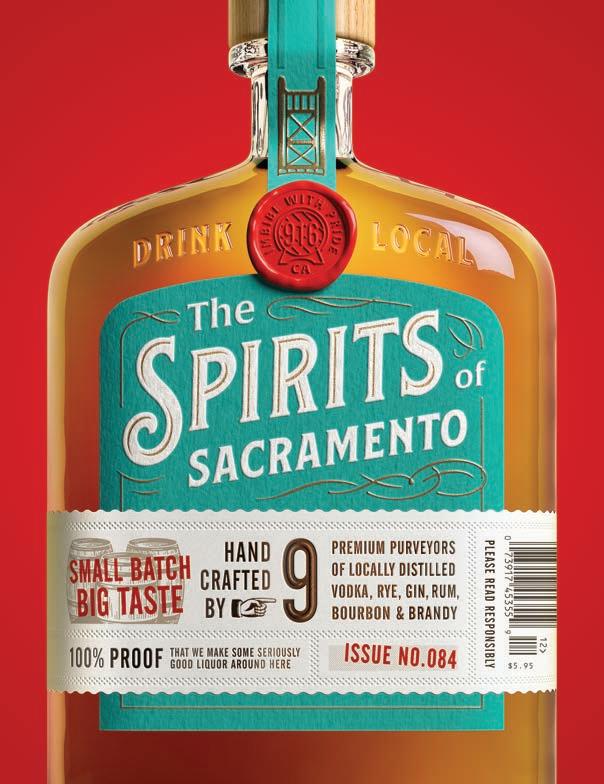
When Foresthill resident Ed Arnold gave up his 20-year practice making prosthetic limbs—a bold career move that started him on the road to pursuing his passion, craft spirits—he discovered that the two divergent fields had common denominators. “They both require very hands-on technical work, and yet there’s a great deal of creative expression involved,” says Arnold, who credits Darrell Corti with sparking his interest in craft spirits in the early ’80s during a Scotch tasting—he had been impressed with the iconic East Sacramento grocer’s expertise on the subject. “I also find the end products much more interesting than something else [that’s also technical and creative], like a small oil painting.” A career switch was still decades out, but it was always on his mind. In 2013, Arnold finally launched California Distilled Spirits in Auburn and never looked back.
His signature approach to making spirits is nuanced, but artful. For example, the fundamental grain mash used to create his bourbon, dubbed The Young Prince after an 18thcentury French royal known as the Duke of Bourbon, is 52% corn and made to his exact specifications by nearby Loomis Basin Brewing. That’s just one point higher than the legal threshold (in comparison, commercial bourbons are 70% to 80% corn, which portends frugality, not necessarily craft). The Young Prince’s higher proportions of barley and rye, along with a two-week fermentation—double the industry standard—result in a spirit that the distiller says is “richer and deeper in flavor.”
The palate of the Darjeeling Gin—which won best in show at the World Beverage Competition in 2015—is described by gin expert Aaron Knoll on his blog The Gin Is In as “a pageant of vibrant full-bodied spice, citrus zests and the comforting warmth of fresh-brewed tea.” Arnold is flattered, but modest about the high praise that his flagship bottle has received. “My flights of fancy just don’t go that far,” he says. Surprisingly, coaxing shades of earth and spice only requires trace weights (mere grams per 30-gallon batch) of nine different botanicals (Arnold cops only to Darjeeling tea, “citrus” and juniper berries, gin’s piney trademark), which are placed in the copper still’s vapor path for unadulterated flavor extraction. That the award-winning spirit is beloved at Shady Lady, Kru, Ella and—cue full-circle moment—Corti Brothers is quite an affirmation for Arnold’s career pivot. “You really can take [a life] that was already good and make it even better,” he says. californiadistilledspirits.com —Leilani Marie Labong

Six years ago, the Boone clan—Jeff, Anita and their adult sons Adam and Eric— were hanging out on their backyard patio in Davis, sipping cocktails and spitballing ideas for a family-run business. A restaurant? Sure, Anita told Jeff, he could open a restaurant if he liked—using whatever was left after their divorce. A brewery? Not in Sacramento’s saturated market, Jeff said, swirling his swizzle stick. Hey, what about an artisanal distillery?
Jeff and Anita quickly became students of their craft, taking fermentation science classes at UC Davis, attending industry seminars and visiting small-batch distilleries around the country, like Leopold Bros. in Colorado and Dry Fly Distilling in Spokane. (Adam and Eric joined in when they could, during military leave and college breaks, respectively.)
Jeff experimented with making mash by first brewing beer in his garage. “It’s that 10,000 hours thing,” he says, referring to the notion popularized by author Malcolm Gladwell that only practice—hours and hours and hours of it—makes an expert. “I’m not going to build a rocket engine, but if something looks doable, from my perspective, you learn about it, put time into it, and you get better at it. We figured it out.”
Patio 29—the name is a tribute to the origin story, with the atomic number for copper thrown in to sweeten the distilling pot, which is made of said metal—launched in August 2019, with a vodka featuring grain-forward undertones and a wisp of weight on the tongue, and a gin distilled with cassia and local lavender (its slightly sweet character is reminiscent of unaged whiskey). The foursome then added an amber-hued rum that evokes banana bread and pineapple, and grappa made with petite sirah or albariño winepress remnants from area vineyards.
Jeff says the family is eager to release its rye whiskey and bourbon—which have been aging in white oak barrels at the Winters distillery for nearly a year—in time for Christmas.
Meanwhile, the company’s current roster also includes a line of flavored whiskeys called Harmon’s Hot Pix, named after a brand of novelty candied toothpicks Jeff’s maternal grandparents devised and sold in the 1950s. These are not your overly sweet college-shot concoctions. Inspired by tipples like the mint julep and Old Fashioned, they are spirit-forward, premixed cocktails ready to pour over ice, sip and savor—preferably on a patio of your own, where apparently great minds drink alike. patio29.com —Jessica Rine

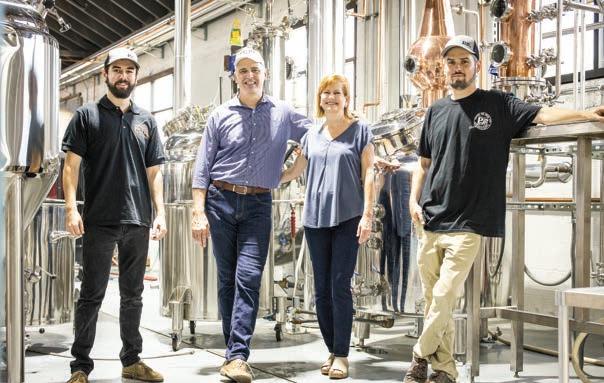
Cris Steller harbors no illusions about the creative licenses left to take in distilling, which has been around for thousands of years. “What we can do is make the most of our terroir, which is different than anywhere else,” says the Dry Diggings Distillery proprietor. “There’s something to be said for the grains and fruits grown here, and the barrels that are aged here.”
That means head distiller Casey Newman’s main job is to bottle the region. The distillery’s signature spirit, Diamond Springs Vodka, leverages the agriculture of the nearby wine country by using a ferment of mostly locally grown grapes rather than traditional potatoes or grains. The two-time winner at the American Distilling Institute’s Judging of Craft Spirits in 2015, including best in class, has a clean finish and the unexpected quality, according to Steller, of being straight-up sippable even though it’s 80 proof. Harnessing the fruits of another neighboring growing region, the AppleJack brandy is crafted from 30 varietals of apples from the Barsotti family orchard in Apple Hill. The spirit, which Steller says “tastes true to a real apple, but in alcohol form,” is made and sold at Dry Diggings’ El Dorado Hills facility under one of his other labels, Amador Distillery. (The two brands, which were launched in 2012 by separate groups, were brought together under one umbrella three years later.) Meanwhile, Dry Diggings’ Rubicon Rye manifests terroir most significantly through the thermal expansion—a phenomenon of El Dorado County’s hot days and cool nights during the spring-to-fall growing season—that occurs during the barrel-aging process, in which the spirit flows in and out of the pores of charred oak barrels for an indulgent four to six years, resulting in notes of caramels and vanillas, not to mention a “big rye spiciness,” says Steller.
Also the head of the California Artisanal Distillers Guild, Steller is a natural north star in the industry: Not only does he consult for emerging local brands like Midtown Spirits (page 64) and Liquid Seduction (page 68), he was among the first to pivot his distillery to hand sanitizer production at the onset of the pandemic here. And he is currently working on a couple more Covid-era game changers: making permanent a temporary measure that allows distilleries to ship bottles directly to consumers and reopening distillery tasting rooms—under current mandates, only establishments serving food are greenlit for service. (In any case, Dry Diggings’ new elevated smokehouse is slated for a late 2021 opening.) “You can only hope that experiences in life are building blocks,” says Steller. “It’s nice to do things that help you and your friends.” drydiggings.com —L.M.L.
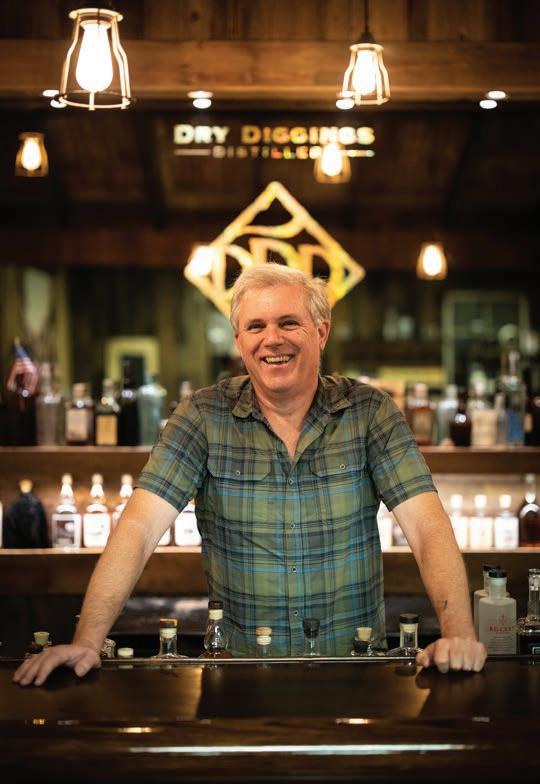
in 2012 Jason Poole, then the bar manager at Pour House, entered Absolut Vodka’s Best Bloody Mary in America contest and walked away with the silver medal. “It was a springboard for me to break off on my own,” says Poole, who had been crafting and selling cocktail mixes as a side gig. That hustle would soon develop into a full-fledged business known as Preservation & Co., a line of pickles, barbecue sauces and said drink mixes. The celebrated Bloody Mary mix, with its uncommon combination of capers, Dijon mustard and house-made balsamic reduction, remains the company’s best-selling product.
The truth is, artisan pantry items—save for the cocktail mixes, the line is currently on hiatus—were just a springboard into Poole’s next venture. “I’ve made the mixes for so long that I want to be able to make the vodka to go with them,” says Poole, 36. “I call it ‘completing the cocktail.’ ” This winter, Poole and his business partner David Abrahamsen, 38, will begin production on their distillery label, Midtown Spirits, at the space formerly occupied by Preservation & Co. near 19th and Q streets. Under the guidance of Cris Steller and Casey Newman from EDH’s Dry Diggings Distillery, Poole and Abrahamsen have been running practice batches of their debut vodka and gin through their shiny new stills since early September.
The vodka has a “balanced mouthfeel with subtle sweet undertones,” according to Poole, thanks to an unusual ferment of rice. Poole and Abrahamsen source otherwise unusable broken grains from Rue & Forsman Ranch in Yuba County, giving their vodka a sustainability shine. The flagship gin, The Not So Dry, is citrus-forward with botanicals of lemon and grapefruit held in a muslin bag that steeps in the distillation kettle. For another variety of gin, this one quite savory and especially good for a Bloody Mary, the two are working with Woodland-based tomato processor Morning Star for its tomato water, a byproduct of the canning process that’s naturally brimming with distillable sugars.
Picking up where Preservation’s abandoned 2019 plans for a downtown eatery inside The Bank food hall left off, an on-site restaurant and bar will open with the distillery this winter. The gastropub fare, from deviled eggs to Devil Dogs (a beef frank loaded with bacon, cheese sauce, tomatoes, jalapeños and onions), provides a cushioned landing for the high ABV offerings. Two dozen house vodka infusions (think caramelized pineapple, horseradish and even roasted s’mores) will be available by the shot or carafe-size mixer. Cocktails on draft will include a tarragon gin lemonade, as well as a Bloody Mary that uses Midtown Spirits’ peppercorn-citrus vodka. But the swig of choice for Poole—a vodka soda—is much less fanciful. “In my career, I have made, and enjoyed, every crazy cocktail you can think of,” he says. “But now I find a simple, spirit-forward drink to be a thing of beauty.” midtown-spirits.com —L.M.L.
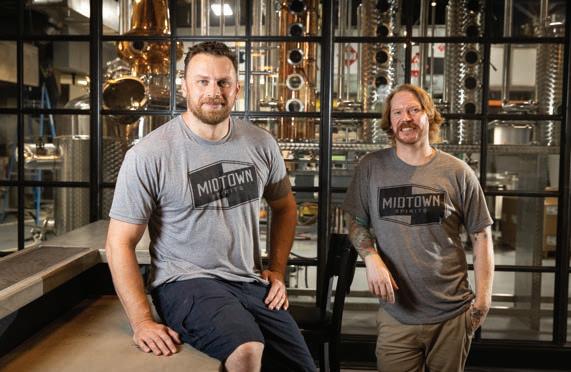

Brian Keck was going for a Ph.D. in chemistry—and brewing saisons and red ales in his kitchen—when he had an epiphany. “My home-brew notebook was a lot better organized than my lab notebook,” he says. “I realized I was a lot more passionate about that.”
His experimental suds quickly became a hit at family gatherings, but one person wasn’t able to join the fun: his dad Kevin, who has celiac disease and can’t consume gluten-containing grains like wheat and barley. Wanting to create a drink that was whole-family-friendly, Keck enrolled at UC Davis in 2014 to study viticulture and enology. But yet another pivot came after his father, with a hot tip on a source for organic potatoes to turn into spirits, suggested that they start their own distillery instead.
Thus, in 2017, the J.J. Pfister Distilling Company was born. The name is a tribute to Keck’s great-great-grandfather John Jacob Pfister, a Swiss tailor who immigrated to the United States in 1869 and founded a knitwear empire—if you’ve ever seen a vintage postcard of a bathing beauty whose wool swimsuit scandalously revealed a bit of knee (gasp!), well, Pfister probably dressed her. (The distillery’s logo bridges the past and present with silhouettes of a pot still and sewing machine.)
Three years, several massive stainless steel vats and nine craft spirits later, the family business is thriving inside a 16,000-square-foot facility in Rancho Cordova, with Keck in the role of master distiller, where he brings a farm-to-fork chef’s sensibility to crafting unique flavor profiles using organic crops. For example, J.J. Pfister boasts a distilled honey spirit called Drakas that sources raw honey from GloryBee in Eugene, Oregon; the popular Capitol Gin, made with local grains and a proprietary blend of nine botanicals; and an eau de vie (fruit brandy) with pears from Greene & Hemly orchard in Courtland—Keck’s personal favorite. And in keeping with the company’s environmentally conscious sensibility, all of the spent grain (excess malt leftover from the distillation process) is delivered to the Silva Bros. Dairy farm’s Elk Grove facility to feed the cows.
Although he never planned to follow in his great-great-grandfather’s entrepreneurial footsteps, Keck hopes the new family business—his parents Kevin and Gail serve as president and COO, respectively—honors the original J.J. Pfister’s commitment to craftsmanship. “I think he’d be proud of what we’ve been able to establish here—that we’re continuing his legacy,” says Keck. jjpfister.com —Curtis Yee

Brothers Romyane Ragsdale, 31, and Andre Woods, 32, have always dreamed big. Soon after graduating from Luther Burbank High School, the pair started approaching the Sacramento City Council with grand plans—for everything from an amusement park to an NHL team. The ideas came and went so fast and furiously that Ragsdale doesn’t remember the first time he came up with the concept to launch a liquor label, but on Nov. 14, 2012, he tweeted: “@FloydMayweather, I have a new liquor concept and I would like for you to be the face of my commercial. Inbox me for more details.”
So when Woods himself suggested a spirits line in 2018, the Mayweather tweet long forgotten, Ragsdale wasted no time, calling every distillery in the region. Eventually the pair got a meeting with Cris Steller of Dry Diggings Distillery in El Dorado Hills. What the two South Sacramento electricians lacked in spirit-making experience, they made up for in enthusiasm, showing up in Steller’s office carrying a pair of striking, handblown glass vessels with an elegantly etched “LS”—the initials of the would-be brand’s name, Liquid Seduction—and a cobalt blue base that they had commissioned from Sacramento glass artist René Steinke. Steller appreciated the brothers’ confidence and happily agreed to help. “He would give us homework,” says Ragsdale. “Every time we completed something on the checklist, we would call him and say, ‘What should we do now?’ ”
“Projects like this come up all the time and eight out of 10 times nothing ever happens, but these guys made it known that they were in this to win it,” says Steller. “I respected their energy and their drive.”
The effort paid off, and in August, the brothers released their first batch of vodka, a clean, wheat-based spirit with a light vanilla accent that was distilled at—where else?— Dry Diggings. “It’s very smooth. It doesn’t have that burn a lot of vodkas have,” says Woods. But with the duo’s go-big-or-go-home mentality, this may be just the beginning. Sharing a life lesson from their high school days playing football (Liquid Seduction’s blue and gold logo serves as an homage to Luther Burbank), Woods adds, “Our coaches always taught us that it’s not about the size of the dog, it’s the size of the fight that’s in the dog.” liquidseduction.com —C.Y.

In 2014, a year after launching Rancho Cordova’s Gold River Distillery—the first distillery in Sacramento County since Prohibition—Greg Baughman was ready to release his debut spirit, Baughman’s Gin. But when he ran the name by an acquaintance in marketing, it didn’t exactly go down easy. “He goes, ‘That’s the stupidest idea I’ve ever heard. Everyone wants to put their name on a bottle, but that’s ridiculous. It doesn’t tell a story,’ ” Baughman recalls.
To find that story, the spirits maker began delving into Sacramento’s alcohol-fueled past, immersing himself in chapter after chapter of hijinks from the Gold Rush era onward. Allegedly, the city was “the easiest place to get a drink on the West Coast” during Prohibition, a time when steam-powered riverboats carted contraband moonshine to San Francisco and back via the Sacramento River right under the Feds’ noses (although Baughman’s own great-grandfather got caught and went to jail for moonshining and bootlegging).
And so it was that the quaffable lineup at Gold River started with a New Americanstyle spirit dubbed Wheel House American Dry Gin, which nods to the titular room on a riverboat and contains subtle hints of juniper and dominating notes of citrus, lemongrass and coriander.
In fact, many of Baughman’s distillates are shot through with local ties. For example, his applejack, a brandy thought to be America’s first whiskey, uses local fruit from the Barsotti family orchard in Apple Hill, and his absinthe verte, a chartreuse-hued spirit that tastes of black licorice thanks to its mixture of botanicals like wormwood, anise, fennel, lavender and spearmint, is a reboot of the digestif that reigned in popularity during the 1800s, when Mark Twain frequented the local saloons.
But Baughman’s pride and joy is the Wheel House Malted Rice Whiskey, which is made entirely from regionally grown varieties of malted rice, a particularly temperamental grain requiring perfectly precise temperatures and Herculean levels of force for pulverization. For the distiller, the result—a signature spirit that, with its caramel notes reminiscent of bourbon up front and a smoky, Scotch-like finish, doesn’t taste like a typical rice whiskey—is well worth the extra effort. “There’s a lot of swearing that goes on when we’re mashing it—but the end product is excellent. And [the flavor] is something new that didn’t exist before.” And the rest, as they say, is history. goldriverdistillery.com —J.R.

f life gives you lemons, add vodka.” So reads a graphic, fittingly, on Norstar Spirits’ Instagram page for its CAS 1854 Vodka. The quote—a humorous, over-21 twist on an old adage—is flanked by two bottles of said liquor, whose sepia-hued label depicts a surveyor’s map of California with a star marking the capital city. “When people see the bottle, I want them to know it’s from Sacramento,” says co-owner Anthony DeCelle. “I’m proud of our town.” And as he explains, a sense of place is further encoded in the sly branding: CAS is SAC spelled backwards and 1854 is the year Sacramento became the state capital.
No doubt helped by its pride-inducing design, Norstar’s inaugural offering has been making a splash all over the region since its 2018 debut, landing at Raley’s and Bel Air supermarkets and more than two dozen area drinkeries, including River City Saloon in Old Sacramento, The Monk’s Cellar in Roseville and Sully’s Bar & Grill in Rocklin. “I love local,” says DeCelle, a Sacramento native who earned his industry chops working at his family’s Beach Hut Deli franchises.
DeCelle founded his Roseville-based liquor company with Clint Goodson, an expert in product distribution, and together they tapped Greg Baughman at Gold River Distillery in Rancho Cordova to help craft their CAS 1854 Vodka. (Norstar plans to expand its offerings by adding whiskey and gin—which would also be made at Gold River—next year.) Perfected through multiple tasting sessions, the easy-to-drink, mixable spirit has a slightly sweet back note, the result of a 16-time distilling process. “That just cleaned it up to where you taste more of the wheat coming out of the product,” says DeCelle. “The minute I tried it, I said, ‘It’s a winner.’ ” norstarspirits.com —C.Y.
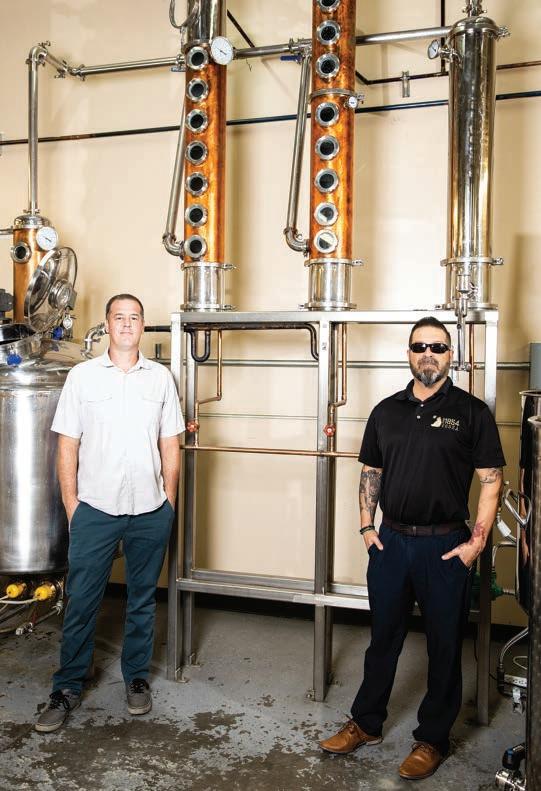
Three years ago, after learning that the Grass Valley research lab at which they worked was about to shut down, physicist Jonathan Dorfman and engineer Dan Kennerson decided to take their technological know-how in an entrepreneurial direction. But what product to make? Their work had ranged from energy sequestration, diamond nanoparticle synthesis and nuclear fusion to developing methods for distilling pure fuel-grade ethanol and deriving oil from algae.
“As much as Dan and I wanted to spin off our own nuclear fusion facility, I don’t think that was the lowest-hanging fruit,” Dorfman quips. The low-hanging fruit turned out to be an olive, plucked and plunked into the smoothest vodka martini that science can buy. Forming the cheekily named Satellite Spirits, the two tweaked their jet-fuel-purification techniques at their Grass Valley distillery to achieve a completely different form of ethanol—a vodka as pure as mountain spring water named in tribute to a popular swimming hole on the South Fork of the Yuba River, one that they both grew up splashing around in. “It’s heaven for hippies,” Dorfman says. “It’s a meaningful drum beat of the region, something we vibe with.”
The main ingredient in the aptly named South Fork Vodka is, in fact, Sierra mountain spring water, along with non-GMO corn. But beyond that, the genius lies in the method—a proprietary approach to purification that outshines more traditional techniques like carbon filtration. Their process greatly reduces the presence of contaminants like acetaldehyde that not only harsh your palate’s mellow, but can also contribute to hangovers in the morning and have even been classified as carcinogenic.
The result is a vodka that Dorfman describes as “crisp, refreshing, unambiguously high quality, highly refined—and incredibly inoffensive.” The crystal-clear liquid goes down so easy that Dorfman and Kennerson like to host tastings of it neat at room temperature. “This isn’t the vodka we grew up with,” he says.
With their signature liquor perfected, the two have trained their sights on other potables. They’ve been experimenting with small-batch specialty spirits infused with herbs like lavender and rosemary or hibiscus and grapefruit. A whiskey is in early-stage development, and two gins may be ready in time for Christmas—a West Coast dry style called Bear River Gin and a California botanical style called Deer Creek Gin, which will feature big floral notes from locally grown aromatics like nutmeg, star anise, angelica root and fennel. But none of these offshoots would be possible without the neutral, odorless vodka, according to Dorfman. “The new spirits are going to be built on this elegant blank canvas,” he says. “We are excited to explore.” satellitespirits.com —J.R.
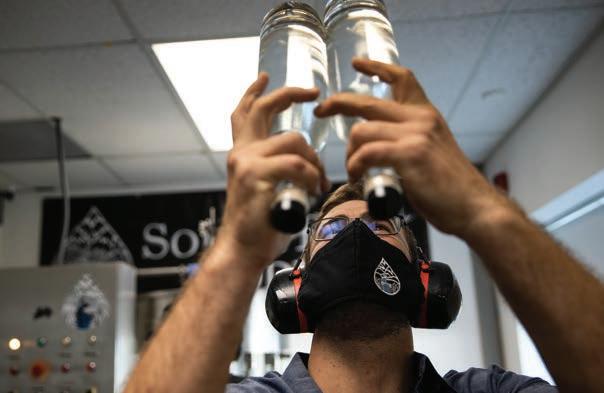

Schools might look a little different this year, but educators remain dedicated to making sure your child gets the education they deserve. Here’s a peak at what a few of our local private schools continue to offer their students.


Jesuit High School is a Sacramento regional Catholic high school that provides young men with a life-building experience and delivers an academically rigorous college-preparatory education to prepare graduates for lives of leadership and service. Home of The Marauders, Jesuit Sacramento has one of the region’s most successful men’s athletic programs, more than 22 visual and performing arts offerings, a robust Honors and Advanced Placement curriculum including the innovative international AP Capstone Diploma Program, an awardwinning robotics program, and a club for every passion. A Jesuit Sacramento education fosters a Men for Others culture, with students volunteering locally on a regular basis and globally during summer immersion opportunities, giving more than 27,000 hours annually, primarily to at-risk, underserved and homeless populations. Discover Jesuit Sacramento today, and build a foundation for life!
4660 Fair Oaks Blvd. Sacramento. 916-482-6060. jesuithighschool.org

Sacramento Country Day School is an independent, coeducational school providing a personal, dynamic and academically challenging environment for pre-K through 12th grade students. Whether your child is entering kindergarten, 6th grade or beginning their high school journey, it’s always a great time to begin an education at Country Day. Our teachers help students find their voices, become enthusiastic, confident learners, and develop generous hearts as they meet new challenges in a safe and supportive environment. We live by our mission to “think critically, live creatively, and act compassionately.” Join us for Virtual Open House Events on November 7. More at saccds.org/open-house. 2636 Latham Dr. Sacramento. 916-481-8811. saccds.org










Celebrating our 80th anniversary, St. Francis Catholic High School continues its legacy of graduating young women who change the world. Our Troubadours are dynamic learners and compassionate leaders, encouraged to discover their passions in every area of their lives. Whether on campus or in our robust and dynamic distance learning program, St. Francis students receive a faith-filled and well-rounded education, with 99 percent of our students attending college. With award-winning visual and performing arts and one of the top female sports programs in the state, opportunities abound. Learn more about our inclusive community of discovery and excellence at stfrancishs.org 5900 Elvas Ave. Sacramento. 916-452-3461.



Merryhill Preschools provide a safe, nurturing environment where children learn, grow and thrive. Our Links to Learning curriculum prepares children for elementary school and beyond by developing important academic, social and emotional skills. Our teachers help each child discover a fascinating world of learning and play. When our students graduate, many continue their education at one of our sister elementary schools located in Elk Grove and midtown Sacramento. 855-722-8938. discovermerryhill.com


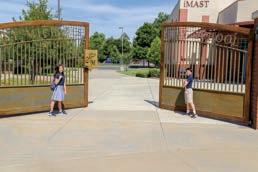


Brookfield School is a learning community where children are nurtured and cherished. Our mission is to encourage and guide our students to develop to their fullest potential, both intellectually and socially. Academic excellence, civility and good character are hallmarks of Brookfield graduates. The curriculum is challenging and balanced, class sizes are small, and students are held to high academic and behavioral standards.Teachers are selected for collegiality, professionalism, dedication to scholarship, and passion for teaching accelerated learners. We are proud of our diversity and emphasize respect and understanding of each other’s differences. Students of all backgrounds are welcome at Brookfield. 6115 Riverside Blvd. Sacramento. 916-442-1255. brookfieldprivateschool.org

Merryhill elementary and middle schools build the solid academic foundation students need for future success. Our schools provide a well-rounded curriculum, personalized learning, and experiences that develop 21st-century skills, such as creativity, problem solving and collaboration. Classes are led by dedicated, skilled teachers who create a warm and nurturing learning community. Multiple locations in the Sacramento area. Pre-K through eighth grade. 855-722 8938. discovermerryhill.com
Sacramento's leading PK-12th grade independent school


SATURDAY, NOVEMBER 7
PK-1ST GRADES AT 9 AM
2ND-5TH GRADES AT 11 AM
6TH-8TH GRADES AT 1 PM
9TH-12TH GRADES AT 3 PM
For more than 55 years, Sacramento Country Day School has delivered the best education in the Sacramento region. Whether your child is entering kindergarten, 6th grade or embarking on their high school journey, it’s always a great time to begin an education at Country Day.
SACCDS.ORG/OPEN-HOUSE


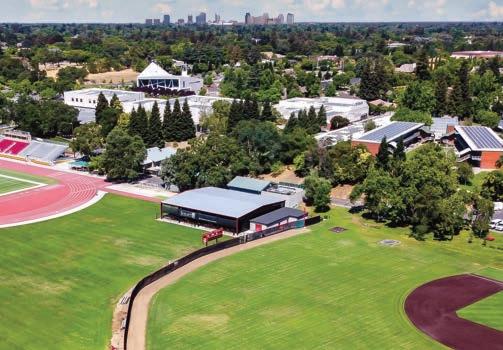



For centuries, mezcal—the ancient intoxicant steeped in Mexican tradition—has sprouted almost exclusively from the vast agave farms south of our border. But one Yolo County hobbyist farmer believes that climate change, of all things, has the potential to spur a California version of the storied spirit to take root right here. And despite extraordinary odds, he might just get his day in the sun.
BY RYAN MILLER
PORTRAIT BY MAX
WHITTAKER
you
could distill California— reduce it to its essence and sip it on a warm evening as the Delta breeze cooled the back of your neck or the sun dissolved into the Pacific—what would end up in the bottle?
There would be a smoky quality, of course—especially these days—but the liquid would still be almost paradoxically clear, like runoff from the Sierra Nevada snowpack.
It would be unique—maybe defiantly so—while still acknowledging that it began life as part of Mexico. It might possess a note of earthiness, of long days of labor and love spent in punishing heat with scarce water.
It would change a little every time you came back to it. Or maybe it would change you. Either way, it would definitely loosen your joints and your tongue—even knock you down, if you weren’t careful.
The liquor would have been shaped by every headline de-

scribing the Left Coast today—wildfires and farmworkers, climate change and cultural revolution, land prices and legal battles—and you would either be fiercely devoted to it or think that the people who couldn’t get enough of it were crazy, snobbish, or a whole lot of both.
It would be comforting, controversial, complex, and probably more expensive than you would like.
If you could distill California, you could very well end up with something like the spirit of the agave. That’s Craig Reynolds’ hope, anyway. His vision—born of a love for the outdoors, Mexican culture and tequila’s cousin mezcal—is for California to someday have its own agave spirits industry. He admits that

this goal is a bit like Don Quixote’s windmill, but as he’s dug deeper into the endeavor, he’s discovered that he’s not the only one tilting toward it.
Standing in the shade of a eucalyptus that marks one edge of his roughly 2-acre field in Woodland, Reynolds looks like he dressed to match Yolo County’s fall color scheme—everything is blue over brown.
On this particular afternoon, the sky looks like it would have trouble remembering it ever held clouds. The clarity is rare for
this time of year, with late summer and early autumn becoming increasingly associated with wildfires that fill the great bowl of the Sacramento Valley with a relentless haze.
To get here, you have to exit I-5 and take county roads that cut straight between expanses of dirt and corn stubble. Harvest has already come for many, and samples of the market-bound bounty that bounced from open trucks dot the interstate highway border.
Reynolds conforms to this natural palette, as well as to its order: brown boots at ground level and a light blue guayabera— often described as a Mexican wedding shirt—at the top.
But there is also a sea of green that comes from about 1,000 nearby Agave tequilana plants stabbing the still September air,

their thick leaves tapering to deadly points that once featured predominantly in Mesoamerican sacrificial rituals. Each plant is about the size of a large air conditioning unit and shaped like a frozen-in-time explosion, ejecta flung upward and outward by mortars fired from Jalisco, Mexico.
In this case, however, the agave plants were shipped from Riverside, California, 407 miles to the south. They arrived as babies in the form of root-like stems scientifically known as rhizomes and colloquially as hijuelos or pups.
Reynolds’ pups began life in a field planted by tequila maker Mark Carlston, who pled ignorance as to the provenance of his own plants. And in 2014, Reynolds planted his first crop of succulents—along with his hopes—into land leased from longtime Yolo County farmer Joe Muller.
Reynolds is committed to spreading the gospel of “Mezcalifornia”—not a movement, he muses, but rather a concept born of equal parts studying the holy documents of climate change reports and faith that plant-killing frosts will become a rarity in the Sacramento area. He enthusiastically touts agave’s versatility, its minimal need for water—critical in a state chronically plagued by drought—and even its unique ability to serve as a firebreak that stops blazes from advancing into more flammable fields.
Indeed, on Sept. 15, nonprofit newsroom ProPublica published an analysis of data from New York-based research firm Rhodium Group, concluding that the coming decades will see historic drops in rainfall levels and rises in average temperatures, pushing agriculture northward. Reynolds believes this climatic shift will force local growers into planting new types of crops to sell.
“Agave’s going to be one of them,” he says. “I’m confident.”
But this will not be a tequila industry. Much in the same way France regulates use of the term Champagne (if it’s made outside of the Champagne region, it’s typically called the more generic “sparkling wine”), Mexico’s private Consejo Regulador del Tequila (the Tequila Regulatory Council) ensures that the appellation is reserved strictly for the distillate of agave grown in Jalisco and four other Mexican states. Nor will Yolo County spirits be called mezcal—a broader appellation governed by the Consejo Regulador del Mezcal and encompassing agave grown in nine states.
No, whatever emerges from this side of the border will be something new, both in name and yes, spirit.
“Part of it is to not just try and replicate something else, but to innovate,” Reynolds says.
Reynolds’ idea first took root during his three decades of work in the California Legislature—specifically while he was serving a 14-year stint as State Senator Lois Wolk’s chief of staff.
“She was the center of the debate about the Delta tunnels and the new version of the peripheral canal and was generally not a supporter of that,” Reynolds explains. “I would jokingly— half-jokingly—tell folks, ‘Well, the problem of this water shift from Northern California to the San Joaquin and Southern California is that these farmers down in Westlands [Water District in western Fresno and Kings counties] are growing high water-use crops like almonds to export to China, and they should be growing agaves and making tequila, which you can do with a lot less water and still get a lot of value.’ ”
Reynolds wasn’t just waxing theoretical. Since 1984, he and his wife Cass have volunteered for Project Amigo, traveling several times annually to help the nonprofit that fosters literacy and educational opportunities for children in Colima, Mexico. The organization had been selling tequila in bottles engraved with its logo to raise money when one of its co-founders suggested in 2006 that they try their hand at making the stuff inside the bottle too. After all, they all liked the liquor, and their facilities manager, Diego Martinez, had a pasture near town that would be perfect for the half-lark, half-experiment of growing their own agave.
So Martinez planted and tended the occasionally ash-dusted 4.5 acres of blue Weber agaves between Volcán de Colima and Nevado de Colima—an active volcano and a dormant volcano, respectively—with Reynolds using his vacation days from the capitol to travel south and serve as project manager over the next eight years.
The agaves ultimately offered up their hearts—or piñas—to be transformed first into a lively spirit and then into scholarship dollars for disadvantaged youth. Reynolds brought in a branddeveloping consultant from Guadalajara and local farmworkers to handle the actual harvest. He rented a distillery and obtained a license to import and distribute the end result, dubbed Dos Volcanes in honor of the nearby peaks that infused the soil with healthy doses of silica and potassium sometime in the Pleistocene.
Martinez’s field was just 3 miles from the Jalisco border, so the resulting blanco (unaged distillate), reposado (aged briefly in oak
barrels), and añejo (aged up to three years) are legally not tequila.
The regulatory nomenclature doesn’t bother Reynolds. The Dos Volcanes website cheekily suggests calling the pure expression of distilled agave “ ‘mezquila’ if you want.”
It also doesn’t bother tastemaker Darrell Corti, known for his preternatural sense for international foods and drinks that will appeal to unsuspecting American palates and become darlings of the fine dining scene around the state. Corti stocks Dos Volcanes at his East Sacramento grocery ($57-$72 per bottle), alongside other items chosen with a legendary discernment that has made him a Moses-like figure, bringing culinary truth down from the mountaintop, for everyone from Chez Panisse’s paradigm-shifting Alice Waters to national food critic and former Gourmet magazine editor-in-chief Ruth Reichl.
Corti says he first met Reynolds “when he came in and tried to sell us his Mexican product.”
“The product was very good, so we bought it,” Corti explains. “It tasted like what distillate from agave is supposed to taste like.” And what is that, exactly? Corti elaborates: “It should have a slightly vegetative, greenish scent and flavor.”
Corti is intrigued by Reynolds’ current efforts to create a local distillate, though he notes that land is typically more expensive in California than in Mexico, where growers also leave their plants to develop for longer.
“It takes seven to nine years of growing to actually get a piña big enough to produce a lot of alcohol,” Corti says.
Unlike strawberries or cabbages, which are planted and picked in annual cycles, a single agave plant ideally takes up its


real estate for the better part of a decade or longer. This can be a daunting—even prohibitive—timeline for growers considering getting into the agave business, especially in an area where the demand for a locally grown product is as-yet unknown. Why tie up land for two presidential terms when it could yield eight seasonal cycles’ worth of a different crop—one with a known market?
“If you can produce the raw material cheaper in another country, that’s what most people do,” Corti continues. “I’m not so sure that growing agave in California is something that we should do. But on the other hand, if people want to do it, this is a free country. You can make or lose as much money as you want.”
But there’s no question that the core product is currently a booming business. IWSR Drinks Market Analysis, which compiles and analyzes alcohol sales data, reported earlier this year that mezcal sales grew by 40 percent in the U.S. in 2019, more than four times the jump in tequila.
And, it turns out, some other people do want to do it. Reynolds’ passion has already proven to be modestly contagious, driven in no small part by his desire to spread the agave gospel. Two more Yolo County growers have already joined the flock.
One is Raul Chavez, who tends an agave-studded hillside about half a mile away, on a ranch owned by Joe Muller’s brother Tom. There, Chavez is farm manager for Tom, and with only a 3-acre site for the agave, the crop is more of an experiment at this stage; a small but calculated wager in case Reynolds’ prediction turns out to be right.
When Chavez rolls up to Reynolds’ agave patch, it’s obvious that he got the blue-over-brown dress code memo. It’s also obvious that he knows his way around agave. Chavez grew up in Tonaya, a town in the Mexican state of Jalisco (agave central) where his family tree has produced multiple jimadors—agave harvesters named for the round-headed cutting tools they wield called coa de jima.
Chavez has personally handled the coa for Reynolds’ own harvest. It takes him only minutes to strip a mature agave down to its piña and send it rolling toward its future as a spirit. One acre can produce about 30 tons of these bulky piñas, with each ton ultimately producing about 100 liters of finished product.
The other Northern California agave pioneer is Andy Donald, a longtime spirits distribution executive, who launched Spirited Farms last year with his former colleague Patrick Ramos, as well as Sacramento restaurateur and bar owner Henry de Vere White.
Separate from the farm, Donald has ambitious plans to open his own distillery in West Sacramento, hopefully, he says, within 18 months. Having worked in the spirits industry for more than a decade, Donald has been quietly prepping to start his own distillation business, named for his great-great-great-grandfather Jackson Temple, a California supreme court justice who served in the late 1800s. He plans a bottling lineup that includes American single malt whiskey, gin, vodka and a spirit labeled Agave de Codorniz—referencing quail as both the state bird and a common target of his hunting hobby.
In anticipation of this undertaking, Donald sought out Reynolds—whom he calls “the don of California agave, at least in Northern California”—and connected through a mutual friend. After a dinner to talk shop, Donald moved quickly to plant about 1,000 agaves on property he leased from his in-laws, coinciden-
tally only about 3 miles away from Reynolds’ and Chavez’s fields, along Cache Creek northwest of Woodland.
He started a year and a half ago, and wants his product to be among the first—if not the first—estate-grown agave spirits in California, meaning the same people oversee both the growing and the bottling, which occur in the same geographical area. And he’s thinking long-term—given agave’s lengthy maturation process, it can take five to seven years for even the fastest-growing plants to reach the size and sugar levels necessary for a good distillate. Simply put, this is no way to make a quick buck. He also wants to plant another 2,000 tequilana agaves next year, along with about 100 of the Espadin variety common to Oaxacan mezcal production.
The fact that there are currently three separate Woodland-


area fields already filled with agave means Yolo County could very well be the historic epicenter of a brand-new California industry.
But even if Andy Donald succeeds in his plans to distill his agave spirits, he will have some big shoes to fill—namely those of Lance Winters, the celebrated master distiller and five-time James Beard Award nominee at Alameda’s St. George Spirits. A California agave distillation market may still be unproven at this point, but that hasn’t stopped the man known to many as the “mad scientist” of craft distilling from challenging himself to pursue it for more than a decade now.
Winters once decided to recreate an absinthe recipe he discovered in an issue of Scientific American, not to distribute—the high-proof, wormwood-infused, anise-flavored liquor with a hallucinatory reputation was banned for sale in the U.S. at the time—but because he could. In 2007, when regulations changed and Winters had perfected his recipe over 10 years of tinkering, St. George was positioned to become the country’s first legal absinthe seller in almost a century.
These days, he uses chopsticks to pull stems off thousands of individual ume plums as part of an elaborate process to fill whiskey-finishing barrels. If it’s laborious and time-consuming and no one else is really doing it, there’s a good chance you can count him in.
And there’s no doubt about it—agave demands an element of masochism. To reach the juice, you have to first hack off all the leaves to reveal the piña. The word translates to “pineapple” in English, and the plant truly does resemble a mon-
strously oversized version of the fruit, especially when the sides are bare and a few green prongs still poke up from the top. Lop those off, and you’re left with something that more resembles a prehistoric pine cone that could give a triceratops a concussion. Winters describes individual piñas as the size of “two sea turtles mating,” which is theoretically helpful in determining a mental scale, assuming you’ve seen the animals in question engaged in the act in question.
Regardless of how you choose to describe it, the piña must be hacked apart, a task traditionally undertaken with a razor-sharp coa, and in some cases, a machete or axe.
The crowning year for Winters’ absinthe, 2007, was the same year his crew first tried processing 38,000 pounds of piñas he acquired from Mexico. Eschewing time-intensive machetes, they first put the raw materials through equipment intended for pulping pears, which promptly broke the machine.
Then they tried chainsaws.
“The agave laughs at chainsaws,” Winters says. “Within just a couple of cuts, the links in the chain were filled with little pieces of fiber, and the chainsaws ended up looking like giant kitten paws, like furry death machines. Just useless.”
They tried and broke a hammer mill they owned, and then a wood chipper they rented, before ultimately finding some success with a commercial dog food mill designed to grind up frozen sides of beef.
However, an unforeseen problem during the fermentation process turned a significant portion of the liquid into vinegar. Winters says they threw away two-thirds of their potential yield, then glumly fed their stills by hand, digging stubborn fibers out of the works with pitchforks and suffering burns when they
weren’t careful. After two weeks of misery, nursing their wounds and hating their jobs, they swore off agave for good.
“Until Craig,” Winters says.
In 2015, Reynolds led the effort to cook plants harvested from Mark Carlston’s Riverside farm, filling a pit that was dug into Joe Muller’s Woodland property and lined with volcanic rocks hauled down from Mt. Lassen. This method emulated the centuries-old practices employed in Oaxaca and its neighboring states, where generations of families have slow-cooked their crops using similar subterranean strategies to make mezcal, as opposed to firing up aboveground ovens typically used in making tequila.
Though their experiment with the agave from Mexico left Winters and his team both psychologically—and literally— scarred, they weren’t so traumatized that they didn’t want to give it another go when given the unlikely opportunity to put a California-grown spin on the distillate. This time, they acquired a knife mill from Mexico, sporting two sets of blades—one rotating, one fixed—that make short work of the stubborn piñas. Why such an investment for something that once had them cursing the day they first laid eyes on a plant heart as large as a pair of passionate marine reptiles?
“Because we’re f--king idiots,” Winters laments. Idiots or not, Reynolds considers the concept of a uniquely California take on mezcal to be proven, a belief bolstered by the response to Winters’ final product in 2015 from some key players in the Sacramento-area food and drink scene. Among them was Patrick Mulvaney, who knew Reynolds from his days working at the capitol.
“He came one day with a small flask and said, ‘Hey, this is the first mezcal from blue agave grown in California, and it was cooked in Yolo,” Mulvaney remembers. “People bring in hooch now and again, and it’s usually horrible, so I expected to taste it and be very polite and say that’s lovely, and he poured it, and I was like, ‘Oh my God! This is amazing!’ ”
Mulvaney, the co-proprietor of Mulvaney’s B&L and one of Sacramento’s most celebrated chefs, wrote to Winters and secured enough of the spirit to include in 2017’s Farm-to-Fork Festival’s crowning Tower Bridge Dinner, mixing it into a prickly pear-based “Yolorita” and proudly informing fans it contained the first blue mezcal distillate grown in California.
Suffice it to say, Reynold’s enthusiasm for locally grown agave has won Mulvaney over. Musing on the skepticism first dished at growers planting pinot noir and chardonnay in Napa, the chef concludes that there’s an opportunity to create history with homegrown agave.
“What’s best about California is that people come here to live their dream and make their second dream, and if we can do that with blue agave, that would be pretty cool,” Mulvaney says. “I think Mezcalifornia has a great future.”
That future also requires a look at the past, and if you want to learn the legend and the history behind mezcal, you have to talk to Ernesto Delgado, whose Mayahuel restaurant in downtown Sacramento doubles as a “museum” devoted to the rich culture
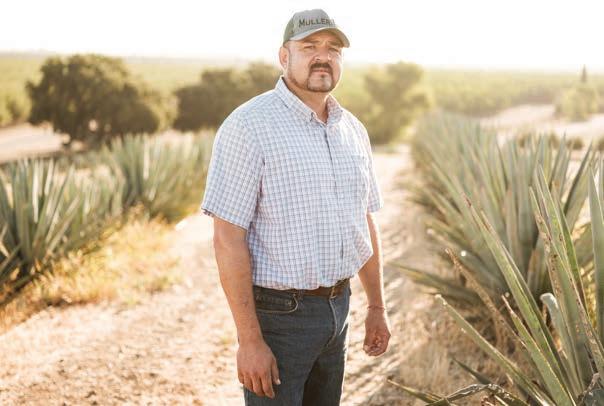
and people who first made the drink.
“It’s a truly fascinating spirit that has been around forever,” Delgado says. “And most people think that tequila is kind of like the parent, but mezcal was first.”
Delgado can’t help but sweep his arms in dramatic gestures when he describes the meaning behind his K Street establishment’s multiple murals depicting Mayahuel, the Aztec goddess of the agave plant and mother of 400 rabbits, each representing a different stage or aspect of drunkenness.
“Yet we don’t drink mezcal to get intoxicated,” Delgado says. “You can have one small glass and it might take you 45 minutes just to sip on it. You can’t shoot it. Your body won’t accept it.”
Take his advice. Delgado’s depth of knowledge and love for the spirit run so deep that seven years ago, inside Mayahuel, he opened what he believes was the first mezcal-only bar in the United States, featuring mezcal-based cocktails, tacos that focus on flavors reflecting where mezcal comes from, mezcal educational events, and a staff happy to answer questions ranging from “What separates mezcal from tequila?” (remember the appellations) to “Why’s it so smoky?” (the aboveground brick ovens used to cook tequila allow smoke to escape through a chimney, while the underground pits where mezcal is made trap the particulates, “almost like they’re marinating the liquid with smoke,” Delgado says).
The restaurant also features potted agaves grown not in Jalisco or Oaxaca, but Craig Reynolds’ field in Woodland.
So how did mezcal first come to be? Dr. Roger Boulton— professor emeritus at UC Davis and former scientific advisor to Patrón tequila—says there was a long empirical knowledge base across the Mexican peninsula, where indigenous tribes grew and cooked pulque: a sweet, pungent and distinctive agave brew.
“Along come the Spanish, invading,” he explains. “They take over, and [that part of Mexico] becomes a Spanish colony. Now that brings with it the church and the distillation knowledge of sacramental wines and fortified wines. And the [result] becomes a regional distilled spirit.”
In other words, mezcal was born some 500 years ago, evolving from possibly thousands of years of tradition rooted in a very specific place. This raises a question: Can a California-centric effort capture what Delgado calls a magical spirit that connects to the essence of place? Whereas other spirits are produced in vast volumes, to be repetitively bottled for uniform nose and notes, mezcal is crafted in smaller batches using recipes and techniques passed from generation to generation.
Delgado speaks in poetic terms when he describes the laborintensive process of making mezcal: “It’s artisanal. It’s more pure. It’s more organic.”
How do you adapt and merge that unique spirit with the practices, advantages and limitations of California, a region devoid of the history that shaped mezcal in the first place? A region where producers choose whirling machines over axes, where distillers like Jackson Temple’s great-great-great-grandson plan to cook their agave in a sterile autoclave, where there are no nearby mango trees that might kiss the fermenting pulp with wild yeast that whispers faintly from the final product?
Delgado admits that he’s struggled with his thoughts on the possibility of a California-based take on mezcal. But he’s also been studying the global creation of cuisine via the migration of people, culture and food in his classes at the Culinary Institute of America in Napa—the region his family moved to from Mexico

when he was a boy. He points out that his fellow countrymen who followed the same dream used to be grape pickers, and now are vineyard managers, winemakers and winery owners. If people can migrate and thrive and grow, he muses, why not agave too?
“If I say agave should only come from Mexico to produce tequila or mezcal, it goes against me being here, growing up here, you know?” he says.
Reynolds’ first harvest of his own plants was in April of 2019, drawing a who’s-who crowd of mezcal fans, foodies—including Corti and Mulvaney—and others interested in the endeavor. Distiller Winters—ever a glutton for punishment—took that Yolo County yield, drawing on everything he learned from his
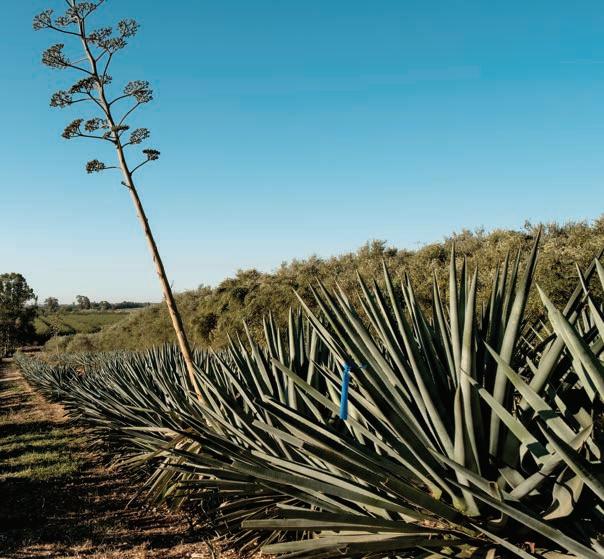
previous two attempts and calling in Dr. Boulton for expert troubleshooting when fermentation stalled at one point. The result is between 36 and 40 gallons of liquor currently sitting at high proof in a stainless steel drum in a warehouse in Alameda.
“It’s such a strange product—which I’m ecstatic about,” Winters says. “It reads like a mezcal. It’s got some light smoke to it, but it’s also got some really interesting mineral and citrus notes. It’s delightful. I really enjoy drinking it, and it was worth all the heartache it took to make it.”
After some deliberation, he decided in October to donate the majority of it—he wants to keep some to drink himself, after all—to the Yolo Interfaith Immigration Network (YIIN), a nonprofit that helps struggling migrant workers and immigrant youth. That group can, in turn, sell the spirit as a fundraiser, assuming they secure appropriate licensing.
Reynolds’ next harvest is planned for November, which will mark another milestone for the man who sheepishly admits that once he committed to growing agave in Woodland, he was simply doing it to prove a point. Now, however, he sees his greatest reward not in the soil or the liquor, but in the community that has coalesced and become united by the spirit of the plant.
And the idea that youth pursuing a dream of education and work with help from YIIN could soon directly benefit from his belief in Mezcalifornia—from his shepherding small, pale pups into hardy, productive plants that are literally pouring their hearts into the broader community—echoes how Reynolds’ endeavor began almost 15 years ago as a fundraising idea for Project Amigo.
Says Reynolds, “I couldn’t think of a better end for the first harvest.”

The Fall 2020 real estate market is, in a word, hot . Multiple local Masters Club members have used the word to singularly describe the state of the market, and rightly so. It’s a seller’s market, with inventory moving like hand sanitizer (fast) and well above asking prices. Abnormal circumstances have made for an atypical market, and Sacramento buyers, sellers and Realtors are tasked with adjusting at every turn. Although times are uncertain, our region’s real estate agents have strategies, tips and tricks that can help all parties navigate the market.
According to the Association of Sacramento Realtors’ most recent report, the median days-on-market dropped from nine to just seven days, and the median sales price is up 10.4 percent year-over-year. The stats go beyond our region to reflect the larger migrational trend of California as a whole: many are making moves to take advantage of various circumstances. In Northern California, urbanites are being tempted to move to Sacramento’s more rural areas for more space at a lower cost, millennials might feel ready to buy a home due to recordlow interest rates, and sellers might benefit from high offers and move out of state completely.
“When the pandemic first started, I assumed real estate sales would come to a halt,” says Lyon Realtor Lisa Rothfels. “That has not been the case at all. Unemployment has soared, yet home prices in our market have hit record highs. The last recession brought housing crashing down, but the pandemic has thus far had the opposite effect.”
Thanks to Sacramento’s up-andcoming reputation, ample space and relatively affordable housing, Bay Area transplants have been settling down in the Sacramento area at a higher rate for several years now.
“The Bay Area has always been a market of ours, but I think the migration definitely has increased in these times,” says director of Coldwell Banker Development Services Michael Onstead. “The fact that people had to shelter at home made them hypersensitive to their current living situation. And in many cases, it wasn't





Roseville/Sacramento | 916-966-4444 | nick.sadek@sothebysrealty.com
With more than 30 years in Sacramento Tri-County real estate, Nick Sadek serves the unique needs of buyers and sellers in this region and from around the world. His goal is to "exceed expectations and create long-lasting, positive relationships." The Sotheby's International Realty brand represents quality and luxury, making it a natural fit with our business and philosophy. The combination of our local knowledge and the Sotheby's International Realty network's global reach provides our clients with the best of all worlds.

Judy
Folsom | 916-533-3344 judy@judyblack.com
Your relocation and property connection! Experienced with your real estate needs and goals in focus… it's all about YOU! Professional Realtor licensed in both California and Nevada. NV RED #0171198; Designations and Certification Awards: CRS, GRI, PMN, AHWD, GREEN, ABR, SRES, MRP
SAR, Outstanding Life Member JudyBlack.com | DRE #01129479
Fair Oaks | 916-224-5843 agitt@golyon.com
As a top producer for over 28 years in the Sacramento area, I base my business on service, value and integrity. I believe in offering my clients the highest level of professionalism and outstanding service. Put my knowledge and experience to work for you!
SAR, Outstanding Life Member angelagitt.com | DRE #01132561




Sacramento | 916-698-9970 tcurry@golyon.com
A consistent top producer, I am dedicated and focused on providing superior service to both buyers & sellers. I provide a complimentary market review to buyers and sellers. A comprehensive package of information to guide them throughout the successful sale or purchase of their home.
Citrus Heights | 916-517-9606 jay@jayemerson.com
Your goals are my focus. I know my business. I know how to find sellers and buyers. I know how to make things happen. I know how to negotiate to Win. I know how to manage to Close. I am a full-time, career professional. I know real estate law, principles and practices.
Association of Realtors’ Masters Clubs are the region’s top producers in residential real estate sales, representing about 10% of the Realtors in the two counties. Not only have they achieved a level of excellence in their industry, but they are also committed to serving the communities in which they live and work.



Toddy Schultz
Laura Moore
Roseville-Granite Bay | 916-716-9069 | laura.moore@cbnorcal.com
Laura has been helping people make the right move since 1999. Her primary markets are the counties of Sacramento, Placer and El Dorado. She was attracted here for the same reason most people want to live here: the warm Mediterranean climate, the rolling hills giving way to the rocky slopes of the Sierra Nevada, the easy access to anywhere you want to be, and most of all the accepting warmth of its people. If you are a seller, she will make insightful suggestions to maximize the desirability of your property and apply strategies for marketing the property. If you are a buyer, she will be an active listener connecting your wants and needs to the most current housing options. Whether you are a buyer or a seller, she will be a tenacious negotiator and advocate constantly looking out for your best interest.
PCAR, Outstanding Life Member lauramoorerealestate.com | DRE #01247653
conducive to working at home while having family with you. So, you can come from the San Francisco Bay Area to Sacramento and get a lot more for your money,” he says.
Jim Anderson of Lyon Real Estate has noticed an influx of Bay Area buyers among his own clientele: “I recently represented three buyers, all of them out of the Bay Area.”
Fair Oaks | 916-342-3573
tschultz@golyon.com
As a consistent top producer for the past 15 years, I specialize in Fair Oaks and the surrounding areas. I have successfully represented both buyers and sellers in all market conditions including the challenges brought on by COVID-19. I am with my clients every step of the way ensuring a smooth and successful transaction. Team Up With Toddy!
SAR, Outstanding Life Member teamupwithtoddy.com | DRE #01483530


Vivian Daley
Sacramento | 916-849-7314
VDaley@GoLyon.com
From new home sales for Powell Development to Realtor/vice president with Lyon Real Estate, I have been a Realtor for 48 years and love it! My background in banking and as a former flight attendant enhanced my desire to serve people. I always try to maintain an attitude of gratitude. No commission is worth my integrity.
SAR, Presidential Member DRE #00475888


Julie Burks
Sacramento | 916-225-0707
julie@julieburks.com
I feel fortunate to have found a career that I love which allows me to make a difference in someone's life. To me, it's really less about winning awards and more about doing what's right for my clients. That attitude is what has helped keep me in business for over 30 years. People know when you care.
SAR, Outstanding Life Member julieburks.com | DRE #01019816


Lisa Rothfels
Fair Oaks | 916-996-8877
lrothfels@golyon.com
It's not just a house; it's your home. Let's Get It Right! When you are buying or selling property in today's real estate market, it is important to have confidence in your real estate professional. My commitment is to provide the most honest, reliable and responsive service possible!
SAR, Life Member lrothfels.golyon.com | DRE #01726096

Mark Delgado
Sacramento | 916-705-2298
mark.delgado@cbnorcal.com
Your home is a huge part of your life, both financially and emotionally. The decision to buy or sell a house is not one to be made lightly. As a Broker Associate with Coldwell Banker, I approach the sale of every property with the highest level of professionalism and care.
SAR, Life Member markdelgado.com | DRE #01411594

Jan Detrick
REALTOR® | 916-812-8180
jdetrick@cbnorcal.com
With over 25 years of experience, my business is based on knowledge, integrity and commitment, building strong and long-lasting relationships with my clients. Whether you’re looking to purchase your first home, trade up, downsize, relocate or invest anywhere in the greater Sacramento region, I can help—contact me today.
SAR, Outstanding Life Member JanDetrickRealEstate.com DRE #01208861
Lyon Realtor Tanya Curry sees the phenomenon as a result of our immediate circumstances as well as steadily climbing trends. “The Bay Area migration has increased even more [throughout the pandemic]. Due to the ability to work from home and not having to physically commute every day, Sacramento is the more affordable choice.”
Curry cites Sacramento’s lower housing prices and less congested lifestyle as the appeal for incoming folks, but notes the inflow can create a challenging market for local prospective buyers. “Often Bay Area buyers are making cash offers,” she says.
Of course, this is great news for sellers. But for locals looking to “move up or buy their first home,” Anderson says, it drives up prices and competition. “Typically, Bay Area buyers are coming with a lot more money.”
While Onstead concedes that nuance is still present, as out-of-area buyers have their own constraints on what they can spend, he says that more often than not, homes are being sold well above listing price. “If you have a single family home almost anywhere, any price range, it’s selling quickly and going over listing price," he says. "Values are going up, inventory is low. We saw one property
go $100K over listing price. [The market is] just really, really robust.”
The exception to this robust climate might be the downtown and midtown areas. Onstead attributes the “slow” downtown market to the closed and boarded up businesses in the area, as well as the limited space and amenities of the homes.
Downtown Sacramento notwithstanding, the market is competitive. However, buyer demand remains high due to low interest rates. In order to maneuver intimidating listing prices, Rothfels advises hiring a Realtor you trust. “A good Realtor will help you make the right decisions for your family and long-term financial situation,” she says. “Additionally you will need to get pre-approved for a loan. A good lender is a must and will be able to give you many different financing options.”
Buyers are armed with clear-cut criteria that sync up with the increasingly specific needs of the time. Curry notes that people are “upsizing rather than downsizing,” and cites “extra rooms, an office, study spaces and outdoor living spaces” as top-ofmind with buyers.
“The most requested feature in a home from my clients has been a home office and bonus space for distance learning,” Rothfels shares. "I’m also finding that almost all of my clients moving here from the Bay Area want a swimming pool. They feel this will help with the adjustment to our hotter temperatures.”
Anderson echoes these observations: “I’ve been seeing lately that people are looking for bigger yards, maybe that little piece of the country


Erin Stumpf
Petersen
Elk Grove | 916-224-1515 | traci.petersen@cbnorcal.com
Masters Club Outstanding Life Member. Traci prides herself in making her clients feel like they are her only clients! Always keeping in mind their wants and needs, Traci has a high referral base for a reason. Her excellent service and negotiating skills keep her clients as clients for life.
Sacramento | 916-342-1372 erin@erinstumpf.com
As a Sacramento native, Erin has helped hundreds of clients buy and sell property. She was Masters Club President in 2012 and currently serves on the Board of Directors for both the Sacramento Association and California Association of Realtors.


SAR, Outstanding Life Member SacREBlog.com | DRE #01706589
Barbara Frago
Sacramento | 916-425-3637 bfrago@golyon.com
As a Presidential Masters Club member, I have assisted clients with a major life decision for over 40 years throughout the Sacramento area. My motto is “During and after, I am always available to answer your questions.”
SAR, Presidential Member barbarafrago.com | DRE #00580837


Sacramento | 916-254-8448 rico@siliconeastrealestate.com
As a new member to the Masters Club, I would like to thank all my clients, friends and family members who have helped me start my own real estate team this past year. I truly love what I do and can't thank you enough for your support! Stay safe and God bless!
SAR, Member SiliconEastRealEstate.com DRE #02008887
SAR, Outstanding Life Member tracipetersen.com | DRE #01267649


Ricardo Saldana
Sacramento | 916-712-7355 ricardo@drrealtygroup.com
I am here to service all your real estate needs with honesty and integrity! Whether you are buying, selling or have rentals, DR Realty Group is here to help. #MoreThanARealtor Sí, hablo español
SAR, Member DRE #01328233

Angela Heinzer
Sacramento | 916-212-1881
angela.heinzer@yahoo.com
Born and raised in Sacramento, I began my real estate career in 1988. My enthusiasm and commitment to customer satisfaction have been the foundation to my success. You’ll love my energetic and hard-working approach...I’ll make your next real estate transaction an enjoyable and smooth experience! Sacramento is my home; I would love to make it yours.
SAR, Outstanding Life Member angelaheinzer.com | DRE #01004189

property sales. I pride myself on communication, integrity and focus. Every client is unique, as is every sale, and my goal is to achieve and exceed my client’s expectations. My business is “referral-only” and my success is thanks to my clients and their successful transactions.



Penni Elmore
Jim Anderson
Sacramento | 916-806-4061 | JAnderson@golyon.com
Where do you see yourself living? Let me help you make the move, locally or globally. I have 20-plus years in the real estate market working with sellers, investors and buyers. With a proven track record and lots of knowledge of the Sacramento area, I also have experience with ranch properties. You can be confident you'll experience a smooth and comfortable process!
"Serving a lifestyle, for your style of life."

Sacramento | 916-835-6000 pelmore@golyon.com
"Penni truly does care about YOU, your HOME and getting the best outcome for all. Professional, kind and with integrity. I would definitely call on Penni again to represent anyone in our family or friends."
~ East Sac Seller
With a deep understanding of local neighborhoods and a passion to serve, exceeding your expectation is my goal.
SAR, Member mckinleyparkhomes.com DRE #01136807



Elk Grove | 916-601-7492 julie.vasu-thompson@cbnorcal.com
Being a twin and fourth generation Sacramentan who comes from a family of real estate professionals, I understand that buying and selling is exciting and challenging. As a passionate top-producing agent with 23 years' experience, I believe in open communication, working towards your goals with your best interest at heart!
SAR, Member DRE #01221444
Michelle Gallagher
Fair Oaks | 916-541-0540
Mgallagher@golyon.com
As a consistent top producer, I have offered exceptional, personalized service to my clients since 2003. Specializing in the greater Sacramento area, I offer comprehensive services on every aspect of the sale. It is an honor to represent my clients, their friends and families on each and every transaction.
SAR, Life Member Mgallagher.Golyon.com | DRE #01382218
life. [They’re looking for] larger houses that will accommodate more people home at the same time. And, of course, since it’s hot outside, they want that swimming pool and the entertaining space outside.”
SAR, Outstanding Life Member JimAndersonSellsHomes.com DRE #01268030


JoAnn Kaleel
Sacramento | 916-402-1817
JoAnn@GoLyon.com
2020 is proving to be an extraordinary year. It’s more challenging, more inspiring and more enlightening than any I have ever known. More time to reflect, more opportunities to be exceptionally grateful for friends and family, and thankful for clients who have become dear friends. Wishing all a wonderful holiday season!
SAR, Life Member DRE #01141918


Julie Reardon
Sacramento | 916-799-0246
JReardon@GoLyon.com
Greetings from your favorite Realtor! Home buying and selling can be stressful. Without exception you must work with an agent you can trust to help you make the best decision for your future. I know I'm that agent, and I look forward to working with you.
Sincerely, Julie Reardon
SAR, Life Member
JReardon.GoLyon.com | DRE #01925466

Mark DeGennaro
Elk Grove | 916-849-4810
Mark@MarkDRealty.com
Specializing in the Sacramento region, I enjoy helping both buyers and sellers achieve their real estate goals!
SAR, Outstanding Life Member MarkDRealty.com | DRE #01394970
Beyond the extra space, Jay Emerson of Galster Real Estate Group notes that buyers are being strategic about HOA expenses. “With loan rates so low, an HOA expense has a much larger proportional impact on a buyer’s ability to finance any amount,” he says.
For those selling during the fall and winter, there are seasonal trends that are hitting on buyers’ needs and niceto-haves. Fire pits, for example, allow for family togetherness and, for those who feel comfortable hosting small gatherings, the ability to spend time outdoors during the colder months.
Rothfels says homes with covered patios, fire pits and large grassy areas are popular requirements among buyers. “If you can't go to the resort, then make one in your own yard!” she says. Dialing up those outdoor entertaining factors can make a home more attractive to buyers looking for homes to accommodate multiple functions.
Although it’s a seller’s market, there are still key considerations. “Sellers still need to price appropriately,” advises Onstead. “You need to listen to your Realtor and try not to second guess the market by going over what comps are showing. Buyers are sophisticated, they're smart. They can see what other sales have been and they don't react to overpriced properties. You still have to be priced and presented properly. You can't be too aggressive or it's going to turn them away.” Rather, he advises trusting in Realtors to take
all factors into consideration, as they are keen to present and price homes properly.
When it comes to being a savvy buyer in this market, it pays to be bold and prepared. “Be willing to pay at least list price or over list price,” says Curry.
Emerson adds that leverage is only gained by taking risks. “A risk, for example, is offering above asking price and telling the seller you will cover any appraisal gap with your cash,” he says. “Obviously, the buyer better have reserves.” When a buyer has their heart set on a property, Realtors agree that it’s worth it to be as aggressive as possible (within their means).
In addition to adopting an aggressive mindset, it’s crucial to make a strong, clean offer. Curry encourages buyers to be prepared by having the approval ready through working with a local lender or the lender partner of your Realtor.
“Provide great terms to sellers, such as short escrow and no appraisal contingencies [if possible],” she says. “Provide shorter contingency time frames and be willing to provide rent back to sellers if needed, as they too may be in the process of purchasing a new home.”
Onstead recommends keeping the offer simple—removing as many contingencies as possible and making offers clean for sellers.
Although the market—and the world for that matter—is undergoing shifts, people are still in search of their dream home, one that will suit their needs both now and in the future. “And with good equity in their current property and low interest rates,” Rothfels speculates, “they will be able to stretch their budget to make it all happen.”


Linda Wood
Sacramento | 916-628-8561 | palomabegin@gmail.com
Representing sellers and buyers of interesting residential and investment property in Sacramento's fine old neighborhoods since 1999. Top 1% Coldwell Banker, International President's Circle, Masters Club Outstanding Life Member, Global Luxury Property Specialist. I like plants, dirt, water, houses and four-legged creatures.
Excellent references upon request.
Sacramento | 916-802-8042 lwood@dunniganrealtors.com
Linda is passionate about serving her real estate clients. She brings experience and expertise to each transaction, making the process as pleasant and stress-free as possible. In addition to being a Five Star Professional Real Estate Agent award winner, Linda has earned the SRES (Seniors Real Estate Specialist) and GRI (Graduate, REALTOR Institute) Designations.
SAR, Outstanding Life Member lindawood.metrolistpro.com DRE #01129438


Sacramento | 916-500-1090
amorris@golyon.com
As a real estate client who is also a REALTOR®, Amy has been on both sides of the client/agent relationship. Her experiences taught her to listen to her clients to come up with creative ways to put their needs first. Amy’s goals are threefold: listen respectfully, speak honestly, and mindfully exceed the expectations of others.
SAR, Member AmyBarkleyMorris.com DRE #01919329
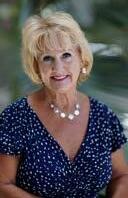
Pattie Mori
Elk Grove | 916-801-9794 pmori@cbnorcal.com
My goal is to establish a real estate relationship with my clients that will last a lifetime by providing them with professional service that exceeds their expectations. I have always felt that by going the extra mile, my clients will get the results they deserve, whether it be in the sale or purchase of their home.
SAR, Life Member pattiemori.com | DRE #00972586
SAR, Outstanding Life Member PalomaBegin.com | DRE #01254423

Roseville | 916-215-3377
Realtor@tamicondie.com
Tami is known as a problem solver and for her pleasant demeanor. She makes sure she listens and understands her clients and their needs and desires. You can relax when she is taking care of things because the job will not only get done, but done right and quickly with top-of-the-line results that you will be extremely happy with.


Sacramento | 916-206-3802
Franco@garciarealestate.com
Let me use my 36 years of experience to assist you in the negotiation of the biggest purchase of your life! Experience has its rewards; profit from mine. I am a Realtor who is with you beyond the sale! Past President of the Sacramento Association of Realtors.
SAR, Outstanding Life Member GarciaRealEstate.com DRE #00925201

Shanda L. Lusich
Elk Grove | 916-214-8479
shanda.lusich@cbnorcal.com
My favorite aspect of being a Realtor is the genuine relationships I develop with my clients. My reputation has given me many repeat clients and referrals, keeping me consistently at the top of my company in sales. You’ll appreciate my southern charm, experience and enthusiasm for my clients’ needs throughout the entire process!
SAR, Life Member shandalusich.com | DRE #01070238


MUSIC & DANCE
THEATER & FILM
LITERATURE
ART & CULTURE
Inspired by Lady Bird, psych-pop artist Anton Barbeau is back home (at least for the time being) after a long spell in Europe. He chronicles his own coming-of-age, leaving-the-nest story in a new double album and music video filled with classic Sacramento iconography.
By Leilani Marie Labong

EEvery time cult musician Anton Barbeau returns to his native Sacramento from the various European cities he’s lived in during the last 14 years, it’s always the quality of the sunlight that makes the place feel like home. “There’s a certain touch of gold to it that’s pretty tangible,” says Barbeau, who left the River City in 2006 to find an audience for his psychedelic pop across the pond—Oxford briefly, then Cambridge for five years, and Berlin for the past nine. Nostalgia for this specific luminescence is something Barbeau has in common with fellow Sacramentan Greta Gerwig, who was purposeful in her use of this at times gauzy, at times glinty glow in her semiautobiographical film Lady Bird, which was the inspiration for Barbeau’s September 2020 release, a semiautobiographical double album called—you guessed it—Manbird
In early 2018, Barbeau had a day off from his Spanish tour and ducked into a movie theater in Madrid to watch Gerwig’s Oscar-nominated “love letter to Sacramento” with his partner, Julia Boorinakis Harper. “After we saw Lady Bird, we joked about doing a film called Manbird. But then I realized that the idea [of an autobiographical project] had real resonance,” says Barbeau, 53, over the phone from the Boorinakis Harper family farm in Auburn, where he’s been waiting out the pandemic since March. “I don’t have a very grounded sense of home, and I knew that would be the heart of this record.”
But while both artistic achievements tackle the classic coming-of-age dilemma that is fleeing the nest—a metaphor that Barbeau interprets for the album cover, which shows him inside a man-sized roost of pruned grape vines, floating down a canal—the singer-songwriter notes that this is also the point of departure from his cinematic inspiration.
“Lady Bird was determined to get out of Sacramento as soon as she could, whereas I based this album on the idea that I was quite afraid to leave,” says Barbeau, who was indoctrinated into the local music scene in 1987 with a performance at Sacramento City College arranged by his voice teacher. From there, he played open mics around town and was the front man for bands called The Psychedelic Love Cowboys and The JoyBoys, which drew many comparisons to The Beatles, Barbeau’s biggest influence—he quips that his earliest memories are of listening to the Fab Four in utero.
Local folk singer Allyson Seconds fondly recalls the early 1990s coffeehouse music scene in Sacramento, singing harmonies to Barbeau’s “Beatles-esque melodies, which were always stamped with that unique and recognizable Anton ‘thing’ for sure.” In 1994, Barbeau ventured solo in earnest, making a dozen albums in a dozen years—those bore deeper shades of his other musical inspirations, British alt-pop artists Julian Cope and Robyn Hitchcock—before finally departing for the UK. “I wanted to stay in the safety of my hometown,” he says.
With more than 30 titles now in his discography, Barbeau has an impressive archive of his musical experimentation, from what he calls the “riddles and sonic Escherisms” of The Village of the Apple Sun (2006) to the odd 17/5 time signature that can be found on Natural Causes (2018) to Manbird’s short palate cleansers of Turkish instrumentals and sarcastic chanting. “I make weird music for normal people,” he says.
David Watts Barton, a former pop music critic for The Sac-
ramento Bee, has been following Barbeau’s music for over three decades. “Something I love about Anton is that his motivations are purely artistic,” says Barton, who currently also lives in Berlin, where he runs into his fellow expat from time to time. “He is absolutely committed to making music, it’s who he is.”
The elaborate and diverse tracks on The Beatles’ White Album served as inspiration for Manbird’s wide stylistic range, a harmonic feat made possible by his motley crew of longtime collaborators, which include singer Allyson Seconds and other local musicians like Larry Tagg of the 1980s rock band Bourgeois Tagg, percussionist Michael Urbano, Cake trumpeter Vince DiFiore and punk vocalist Jonah Matranga, former lead singer of Far. Most of the music-making for the double LP—save for occasional tracks recorded in Barbeau’s ad hoc studios on the Boorinakis Harper farm and at his dad’s East Sacramento house—was accomplished by trading MP3s via Dropbox from 2018 to 2019. “The musical guests really give the album an extra sense of place,” says Boorinakis Harper who is also the founder of Barbeau’s record label, Beehive Sound.
Manbird’s sonic complexities—from the industrial urgency
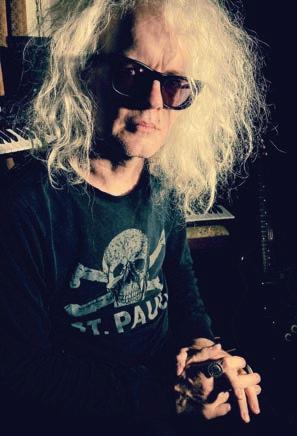
of “Even the Swans are Dirty” to the ABBA-inspired “Memory Tone” to the punk anthem-in-the-making “Featherweight”—are interwoven with Barbeau’s life story, told in self-described “cryptic” lyrics speckled with Easter eggs that only Sacramentans would appreciate. Still, some local references have been pulled from so deep in his memory that they couldn’t possibly click for anyone but him. “He looks both backward into his influences and sideways into totally different territory,” says Boorinakis Harper. “It’s a very intentional album.”
For example, in the electronic lullaby “Dreamscape 4,” Barbeau transports the listener back to 1970 and his family’s first home near Sacramento City College, where he spent his toddlerhood “bouncing on a waterbed” and trying to make sense of the “poncho-wearing hippie kids” milling about the neighborhood. Some River City remarks are both obscure and quirky, like “the world-class parking meter[s]” of Sacramento in the catchy refrain of “And So Flies the Crow,” while others are instantly recognizable: The song “Manbird,” for example, contains a reference to one of Barbeau’s “fountains of youth,” the McKinley Park pond.
In a tidy lyric from “Across the Drama Pond,” a title that refers to Barbeau’s “petty bickerings with various people” that date back to his teenage days, the songwriter quickly descends from haughty heights (“Captain Midtown was my name,” he sings) and into a modest confession (“I never left the grid for fear I’d lose my innocence abroad”). For all of the value that birds lend
to this album, staying within the comfort of a well-roosted nest is as much a metaphorical consideration as flying the coop.
After nearly 15 years, Barbeau is still trying to catch on in Europe. Not surprisingly, he has a devoted audience in the UK, probably because his musical influences are easily recognized and beloved. While he fronts a French rock band called Salt, he’s not known by name in France. Apparently he does well in Spain. And in Germany, where he’s been living for almost nine years, Barbeau admits, “I don’t have much of a fan base there.” But Barton believes that this sort of “failure to launch”—or in this case, take wing—may be deliberate, at least subconsciously. “I’m not sure Anton wants anything mainstream,” says the music writer. “He is a born cult figure. God help him if he ever became rich or famous.”
Back home, as a lyric in the title track suggests, he is a “hall of famer,” having been inducted into the Sacramento Area Music Awards Hall of Fame, along with other local acts like Cake, Deftones and Jackie Greene. For the glam-tinged “Manbird,” Barbeau and Boorinakis Harper took a cue from Gerwig’s closing montage of iconic Sacramento sights in Lady Bird, creating a multimedia video with a poignant tour of the city playing across a green screen. Filmed this past spring, the reel features places like Club Raven, Gunther’s, Pancake Circus and Tower Theatre from the perspective of a moving car. And sometimes, between palm tree tops and neon signs, the lens catches the sun, turning the picture to gold. S

From prime grade and dry aged to a variety of other outstanding rib roasts, talk to the talented butchers at your local Nugget Markets to reserve the perfect centerpiece for your feast. nuggetmarket.com


FEED YOUR MONSTER APPETITE AT


Eat well. Live well. RESTAURANTS
FOOD & WINE
BARS & LOUNGES
COCKTAILS


A
next-gen Persian restaurant opens in midtown, serving up classics like saffron-seasoned, flame-grilled kebabs alongside newfangled Old Fashioneds infused with smoked tea leaves. by Leilani Marie Labong
For Idean Farid, as the saying goes, the way to his future wife’s heart was through her stomach. To hear him tell it, his version of baghali polo was the chef’s kiss that sealed the deal with his then-date Jen Tkach back in 2009 while they were both students at San Francisco State. “I remember bragging to her about Persian food and my cooking skills,” says Idean, 31. “And she called me out on it.” He invited her to his apartment to try the traditional Persian rice dish: long, buttery grains of steamed basmati flecked with fresh dill, studded with big, meaty fava beans and finished with an anointment of bloomed saffron.
“I don’t know if that’s when I fell in love, but I was definitely into it,” teases Jen, also 31, whose family hails from Czechoslovakia. “It was one of my first tastes of Persian cuisine and I loved it.” The trappings may have been different, but at its heart, the baghali polo was as familiar to her as rice pilaf.
Such surprising recognition is the secret sauce behind Maydoon, the new Persian restaurant in midtown that Idean and Jen Farid—who wed two years ago and now live in El Dorado Hills with their 5-month-old son, Mo— opened in June for outdoor dining and takeout. Taking into consideration any misconceptions that may tinge some Americans’ perception of Iran due to the country’s long history of political conflict with the U.S., the ancient gastronomy of Idean’s heritage—in 1984 his family left Iran, landing in Gold River and opening M. Shahrzad

Fine Persian Cuisine in Rancho Cordova 20 years later—may seem doubly unapproachable.
But sizzling among the cuisine’s rich stews and long braises, not to mention its unabashed flaunt of verdant herbs (parsley, cilantro, mint and dill) and warm, aromatic spices (turmeric, sumac, cumin, cardamom), is one of the world’s oldest barbecue traditions: the kebab. In episode six of Padma Lakshmi’s Hulu series Taste the Nation, an exploration of global culture and food traditions in America, the kebab is not only pegged as “the king of the foods for Persians,” but also as “an olive branch to Americans.” After all, fire-roasted meat on a stick is bound to tug at the carnivorous heart of anyone who grew up with a backyard grill.
At Maydoon, koobideh has emerged as the most popular kebab, which mirrors its standing in the Persian community, although a close second goes to joojeh—large pieces of chicken breast marinated overnight in olive oil, lemon, salt, pepper, saffron powder and turmeric. “In my country, everybody loves kebab,” says Mohammad Farid, Idean’s father, a co-owner of the restaurant. To prepare koobideh, the cooks at Maydoon, working off an old family recipe, robustly season ground sirloin with onion, turmeric, salt and pepper. When the mixture is molded onto a length of skewer, small indentations are made along the way to help the meat cook more quickly and evenly on a flaming grill. The signature koobideh emerges from the fire after about eight minutes, slightly singed on the outside and tender and juicy inside, not unlike the hamburger of your dreams. Stuffed inside pita bread with fresh herbs, pieces of fire-roasted tomato and perhaps a slather of mast-o-khiar (thick
yogurt mixed with cucumber and mint), it could be.
Other highlights include the Maydoon Bowl, featuring layers of saffron-scented rice, chopped cucumber-and-tomato shirazi salad and koobideh, joojeh or tomato-braised shredded lamb, and a signature wrap that tightly bundles shirazi salad, the kebab of your choice, and a zesty green sauce of garlic, cilantro and parsley inside rolled-up lavash. The latter, in snack-size form, also appears on the happy hour menu, alongside apps like dolma (stuffed grape leaves) and kashke bademjan (grilled eggplant dip), two authentic carryovers from Idean’s family’s previous restaurant.
Earlier this year, the Farids sold the popular Shahrzad, leaving behind its heavy faux stone finishes and photographic murals of Tehran to open Maydoon. The new setting—Idean and Jen renovated the spot near 16th and P streets that formerly housed Nishiki Sushi—features recessed arches, intricate tilework and gold metal light fixtures, elements from classic Persian architecture and design. Crisp white walls and blue-green accents on the entryway floor tiles nod to the nearby Mediterranean Sea and a welcome mural—a flowy, floral monogram by local painter Anton Kagounkin—depicts Iranian botanicals like the pomegranate and the crocus flower, the stigmas of which are the prized saffron threads. It’s a modern look for a new generation of Persian restaurant diners who are poised to help Maydoon live up to its name, which loosely translates to “gathering place” in Farsi.
Meanwhile, socially distanced patrons can toast to Maydoon’s creative cocktail menu, which includes a riff on an Old Fashioned called Baba Jafar, named after Idean’s late grand-

father and made with Four Roses bourbon infused with smoked Persian tea leaves, plus a dash of walnut bitters. “He was a laidback guy who liked cigars,” says Idean. “When he visited family in the U.S., he loved to drink bourbon. This is the drink I would have made for him—it’s influenced by the things he enjoyed.”
Other crafted libations like the Maydoon Mule, made in the traditional way save for a swirl of sour-cherry syrup, and the ginbased Cucumber Cooler with mint syrup, cucumber shavings and seltzer, hold a distant vision of childhood. “As kids, playing in the summer heat, Idean and I drank different [nonalcoholic] elixirs mixed with either sour cherry or mint syrup. It was a great way to cool down and keep ourselves hydrated,” says Shahriar Nejad, a family friend. “Idean and Jen took that memory and added booze—so I guess we’re still staying hydrated.”
Tastes of Idean’s youth can also be found in Maydoon’s khoresh, or slow-cooked stews. Word on the street is that every Iranian family has a treasured recipe for ghormeh sabzi (a beefand-kidney-bean stew) and gheymeh (a beef-and-split-pea stew spiced with saffron and turmeric, scented with dried Persian limes called limu omani, and finished with fried potatoes).
The former ranks among the “10 Essential Persian Recipes,” according to Samin Nosrat, an Oakland-based chef and host of the Netflix series Salt Fat Acid Heat that was based on her best-
selling culinary reference book of the same name. The latter is a favorite of chef Andy Baraghani, who as a senior food editor at Bon Appétit demonstrated making the dish in 2018 for the magazine’s popular YouTube channel after getting reader requests for more Iranian recipes in the wake of his story on Nowruz, or Persian New Year. That two high-profile, next-generation Iranian-American food stars proudly rest their reputations on the dishes they grew up eating (both admit to childhoods spent trying to assimilate into this country’s culture by throwing away, or at the very least attempting to conceal, their school lunches packed with kuku, an herb frittata), speaks to the deepening stake of Persian gastronomy in America’s melting-pot society.
The ghormeh sabzi offered at Maydoon uses Idean’s grandmother’s recipe. It’s one of Jen’s favorite foods, Persian or not. Richly flavored with slow-simmered beef and beans, plus fragrant nuances from limu omani, cilantro, scallions and fenugreek leaves, the stew—often served over tahdig, the famously finicky Persian crispy rice, a bottom-of-the-pot miracle that’s on Maydoon’s secret menu—epitomizes warmth, making it a perfect dish not just for winter, but also for welcoming diners to this new gathering place. S
Maydoon. 1501 16th St. 916-382-4309. maydoonrestaurant.com



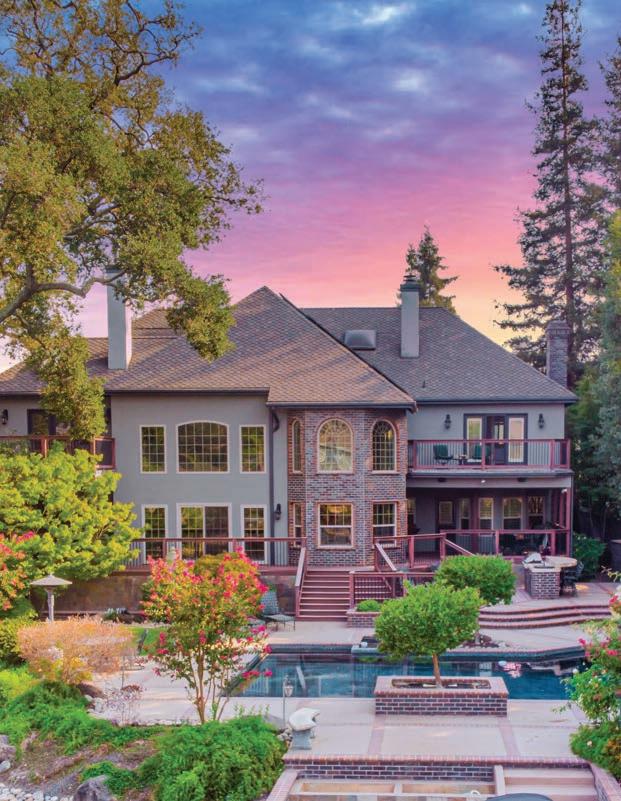



LODI | $1,995,000



Luxury living along the river in Lodi. Extremely well cared for home offering just under 5,000 sq. ft. of space with 5 bedrooms & 4 bathrooms. The backyard oasis beckons you to sit back and relax by the custom built pool/spa, BBQ area & 50' custom dock. Inside you will find spacious bedrooms, a 3-desk home office, sewing room, state-ofthe-art movie theater & billiards room. Don’t miss this one!
Richard Goore 916.870.6896 richard.goore@cbnorcal.com | CalRE #02019995



SACRAMENTO | $1,199,990 Exquisite Tudor on highly sought after street in East Sac. Four bedrooms, 2.5 baths and 2,400 sq. feet of fine craftsmanship you can call home!
Steffan Brown 916.717.7217 steffan@steffanbrown.com | CalRE #01882787


AUBURN | $1,130,000

5br/5.5ba home in Saddleback Estates. Features a library, formal dining & living rooms. Downstairs master and guest wing. Kitchen with large pantry & island. Family room w/a wet bar, fireplace & pool access. 5.5+ acres.
Susan Richards-Slavik 916.873.0935 susan.slavikre@gmail.com | CalRE #01967494














EL MACERO | Price Upon Request
Classic 1962 ranch-style home with 4 bedrooms, 3 fulls baths, 2 car garage, 2 fireplaces & an enclosed breezeway. The .38 acre lot is located on El Macero Country Club Championship Golf Course!
Dana Hawkins 530.219.5076 dana.hawkins@cbnorcal.com | CalRE #01318897



KINGS BEACH | $829,000
A beautifully remodeled lake view, 3br/2ba, condo located in the lakeside Brockway Springs Resort. Year-round hot spring fed pool overlooking Lake Tahoe, with waterfront tennis courts, gym, sauna, pier, and clubhouse.
Lenny Novick 530.412.2340 | CalRE #00561304
Chris Hanna 530.412.1654 | CalRE #01292302


ELK GROVE | Price Upon Request
Welcome to this custom 5br/3.5ba home with a private backyard offering a patio, built-in pool, outdoor fire pit area, artificial turf and a separate garden. Enjoy vaulted ceilings, a breakfast nook, a fireplace and more.
Jan Detrick 916.812.8180 jdetrick@cbnorcal.com | CalRE #01208861


FAIR OAKS | $859,900
Custom home features oak trim, separate family and living rooms, and beautifully equipped, detached guest quarters. 3-5 bed, 3 baths. The newly resurfaced pool is pure delight during hot Sacramento nights!
Leah Cox 916.521.2672 leah.cox@cbnorcal.com | CalRE #01989623


SACRAMENTO | $799,990
This unique 3 bedroom, 3 bath entertainers delight features arched doorways, a soaring barrel ceiling, charming fireplace, gourmet kitchen with farm sink, massive master bedroom and landscaped backyard.
Steffan Brown 916.717.7217 steffan@steffanbrown.com | CalRE #01882787


CARNELIAN BAY | $699,000
Rustic "Old Tahoe" 2br/1ba cabin with a detached 2-car garage that features a studio & 1 bath guest unit above. Great location on a private road.
Tom Mills 530.318.1376 thomas.mills@cbnorcal.com | CalRE #00756102














ROCKLIN | $599,500
This beautifully maintained 4-bedroom 2-bath open concept home on a premium oversized cul-de-sac lot. It features newer updated appliances and HVAC system, kitchen island, granite counter tops and private master suite.
Laura Corbin 916.626.2800 laura.corbin@cbnorcal.com | CalRE #02020448


SACRAMENTO | Price Upon Request
A sophisticated ease of living at this 3br/3.5ba home in Huntington Sierra Oaks community. The home includes a spacious kitchen, formal living and dining areas & 2 expansive master suites, one with a private balcony.
Rich Cazneaux 916.212.4444 rich@eastsac.com | CalRE #01447558


ROCKLIN | $539,900
Come discover your stay-cation paradise in this three bed, two bath, approximately 1,486 square foot single-story home. Move-in ready, you can enjoy views of the pool and emerald synthetic lawn from almost every room.
Sarah Dalton 916.802.0384 sarah.dalton@cbnorcal.com | CalRE #02042448


SACRAMENTO | $588,000 Elegant 3br/3ba home w/2 car garage features a kitchen with eating area, island & Corian countertops. The family room offers a gas fireplace & glass French door. The master suite has shower, soaking tub & walk-in closet.
Tecca Wysk 916.205.8973 tecca.wysk@camoves.com | CalRE #01308218


ORANGEVALE | $550,000 4br/2ba single-story living. Great room w/ combined kitchen, dining & living room. Backyard w/ fenced pool, waterfall feature, fire pit & sport court!
Melissa Quade 916.936.8855 melissa.quade@cbnorcal.com | CalRE #02012631


ELK GROVE | $535,000
Beautifully remodeled Camden Passage Gem features a nice rear yard w/patio, raised planters & raised bed garden area. It offers kitchen with upgraded appliances, extra-large family room & master bedroom w/walk-in closet.
Richard Landrey 916.205.6639 richard.landrey@cbnorcal.com | CalRE #01017177

VISTA | $524,900
3br/3ba move-in ready single story home on 2.9 peaceful Meadow Vista acres. Spacious family room, country kitchen, master bedroom w/en-suite bath, covered front & back patios, outbuildings, room for animals & your toys.
Danielle Larson 530.906.1889 danielle.larson@cbnorcal.com | CalRE #01469169


SACRAMENTO | $479,900 Welcome to this phenomenal College Greens 4br/2ba approximately 1,771 square foot single-story showcase. In the past two-years, the selective owners have remodeled both the interior and exterior to their high standards. Sarah Dalton 916.802.0384 sarah.dalton@cbnorcal.com | CalRE #02042448











WEST SACRAMENTO | $415,000
3br/2ba updated bungalow w/ features hardwood floors, a gorgeous antique front door, a gas fireplace and mantle, custom crown moldings and a cute kitchen with gas range, enclosed backyard & porch.
Sarah Dalton 916.802.0384 sarah.dalton@cbnorcal.com | CalRE #02042448
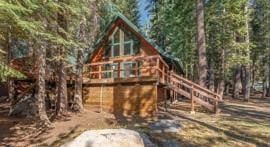

SODA SPRINGS | $409,000
Enjoy the lovely setting with a sunny deck, vaulted wood ceilings and expansive windows. Other features include wood windows, custom iron railings, pellet stone, Silestone kitchen counters, spa tub & generator.
Lynn Richardson 530.412.0706 lynn.richardson@cbnorcal.com | CalRE #00937210


IONE | $299,000
This huge updated 5br/3ba home is beautiful and elegant. The home features newer counter tops, newer flooring, fresh paint, fresh driveway, newer landscaping and many more updates. All this on a huge cul-de-sac lot!
Tammy Goolsby 209.332.0250 tammy.goolsby@cbnorcal.com | CalRE #01987204


SACRAMENTO | Price Upon Request
2br/2.5ba home upgraded w/ quartz countertops, custom window coverings & appliances. Kitchen features an island w/a sink, seating & cabinetry w/pullouts. Third level includes a spacious master suite & a guest room.
Sabra Sanchez 916.508.5313 sabra.sanchez@cbnorcal.com | CalRE #01820635


ELK GROVE | $329,900
Welcome to The Aspens, a gated community in Laguna. This two bedroom, two bath home invites you into the great room and an updated kitchen with stunning granite. Unwind in the tranquil backyard with many fruit trees!
Traci Petersen 916.224.1515 traci.petersen@cbnorcal.com | CalRE #01267649


SACRAMENTO | $215,000
Second story home features a bright open floorplan with tons of natural light, gas fireplace & 2 bedrooms. The grounds are meticulously maintained and offer a serene environment with waterfall and streams.
Jeff McKey 916.541.6111 jeff.mckey@cbnorcal.com | CalRE #01981069
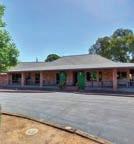
WILTON | $1,100,000
4br/4ba ranchette with den, game room, old-world style kitchen, master bedroom w/fireplace, a pool & barn.
Tori & Toni 916.261.8546 tleicht@cbnorcal.com
CalRE #01212789 | CalRE #01307279

4br/2.5ba

4br/2ba home features an extensively remodeled kitchen, remodeled master bathroom, solar heated pool and outdoor fireplace with custom patio cover.
Destiny Slothower 916.806.2207 D.Slothower@yahoo.com
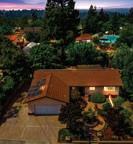

counters. Enjoy the huge backyard.
Sande Blevins 916.718.6099 homes@sandeblevins.com
CalRE #01291035


ROCKLIN | $449,000
3br/2ba home w/a Tahoe feel in Rocklin neighborhood. Relax with
Lynnette Martelle 916.532.0335
lynnette.martelle@cbnorcal.com
CalRE #02035832

3br/2ba east facing home w/kitchen featuring SS & quartz counter. Backyard: waterfall & built-in bar. Don't miss out, call this house your home today!
Lisa Marie Ratliff 916.879.5472 lisa.ratliff@camoves.com
CalRE #01883204 AUBURN | $510,000

3br/2ba one-of-a-kind home w/custom cabinets, original hardwood floors and a cozy, cabin feeling. Enjoy the back deck and beautiful yard.
Leah Cox 916.521.2672 leah.cox@cbnorcal.com CalRE #01989623
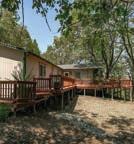
Nev Kordic 916.532.0325 nev.kordic@cbnorcal.com CalRE #01308908
CalRE #01518926 ORANGEVALE | $474,900

SACRAMENTO | $425,000
& manicured garden.
Angela Heinzer 916.212.1881
angela.heinzer@cbnorcal.com
CalRE #01004189

jillianrealestate@gmail.com
CalRE #01982012

SACRAMENTO | Price Upon Request
3br/2ba home in an established neighborhood! Living room w/ a cozy fireplace & well-appointed kitchen. Large sunken family room opens to the backyard.
John Corin 916.947.7831

john.corin@cbnorcal.com CalRE #01418706 ANTELOPE |
Ben Padilla 916.412.7087 benjamin.padilla@cbnorcal.com CalRE #01873788

CITRUS HEIGHTS | $375,000
Stunning single story 3br/2ba home features a bonus sunroom, wood flooring, remodeled kitchen w/newer appliances, granite counters & redone bathrooms.
Destiny Slothower 916.806.2207
destiny.slothower@cbnorcal.com CalRE #01883204

SACRAMENTO | $288,500
SOLD: Move-in ready 3br/1.5ba single-story, bright floorplan home w/large welcoming backyard and storage shed.
Tracie Colamartino 916.765.0581
Janet Hayden 916.207.1277
CalRE #01185269 | CalRE #00770040

SACRAMENTO | $337,000
Charming single level home on Herbosa Vista Court. This inviting home features four bedrooms, two full baths, and a two-car garage. Welcome home!
Teresa Gilland 916.612.0511
teresa.gilland@cbnorcal.com CalRE #01943131

ORANGEVALE | $283,500
Remodeled 2br/2.5ba town home with an updated kitchen w/granite counters & stainless steel appliances, open living room with fireplace & master suite.
Sande Blevins 916.718.6099 homes@sandeblevins.com CalRE #01291035

SACRAMENTO | $388,900 Welcome

Mark Peters 916.600.2039 mark.peters@cbnorcal.com CalRE #01424396 SACRAMENTO |
Melissa Quade 916.936.8855 melissa.quade@cbnorcal.com
CalRE #02012631

SACRAMENTO | $325,000
This charming home, updated in 2017, offers three bedrooms, two bathrooms with approximately 1,470 square feet of livable space.
Timothy Pantle 916.834.6376 Tim@TimPantle.com CalRE #01377493

SACRAMENTO | $195,000
Welcome to Timberlake Waterfront Community! Rare opportunity with lower level 2 bedroom remodeled condo in serene location overlooking the waterways.
Tarah Pahlavan 916 280 7175
tarah.pahlavan@gmail.com CalRE #02024258

CITRUS HEIGHTS | $295,000
Welcome to this beautifully redone one-half plex in Citrus Heights. The owners have gone though and made tons of upgrades and replacements.
Barbara Silva 916.718.6244
barbsilva@comcast.net
CalRE #00986087

LINCOLN | Price Upon Request
This renovated four bed, two and one-half bath home has a large yard. Enjoy stainless steel appliances, a vaulted ceiling entry and fireplace.
John Corin 916.947.7831
john.corin@cbnorcal.com
CalRE #01418706

Now Open: Tahoe Blue Ridge Bar at the DOCO Plaza. In partnership with the Sacramento Kings, Tahoe Blue Vodka has opened the Tahoe Ridge Bar alongside several restaurants as part of a new outdoor dining concept in downtown Sacramento. The DOCO Al Fresco concept allows guests to safely dine, sip on their beverage of choice, and enjoy live music (times vary). Open Friday and Saturday from 11 a.m. to 9 p.m., Sunday from 11 a.m. to 8 p.m., and Monday through Thursday from 4 p.m. to 9 p.m., guests can order from various restaurants and the Tahoe Ridge Bar on a single tab. Hours subject to change. Reservations are encouraged. docosacramento.com/alfresco


NorCal’s largest contemporary design center is now proud to offer fantastic kitchen, bath and closet remodeling options by German Kitchen & Bath. You can afford world-class German quality by BauGroup manufacturing and Miele appliances, complete with the unbelievable durability of Dekton® countertops. Discover the latest home innovations that will last for decades—some with limited lifetime warranties. Our friendly no-pressure staff can help make your dreams a reality. We have practically everything to make your remodeling projects perfect the first time, including European fixtures and doors. Visit German Kitchen & Bath at Furnitalia today. One source, endless possibilities. furnitalia.com


The right place, the right time. Let Fountains be your destination this Holiday Season. Discover great restaurants and unique shops with one-of-a-kind gift ideas. All while strolling a beautiful, family friendly, outdoor environment. Happy Holidays! Fountains at Roseville is located at the corner of Galleria Boulevard and East Roseville Parkway. fountainsatroseville.com
The California Academy of Sciences is now open! Reunite with all your favorite animals, like the African penguins, jellyfish, Claude the albino alligator and more. Plus, every visit supports the Academy’s cutting-edge scientific research all around the world and the nearly 40,000 live animals that call the Academy home. After being closed for many months, the California Academy of Sciences can’t wait to welcome you back. Reserve your tickets now and learn how the Academy is keeping you safe at calacademy.org
In Tokyo, a renowned architect conjured up an elegant solution to a not-soelegant urban problem: public toilets. Sacramento needs to take the plunge on his creative idea to build restrooms with, yes, see-through walls. by Rob Turner

In most big cities, public bathrooms are a necessity, but here in Sacramento, they barely exist. In fact, a recent effort to place one in Cesar Chavez Plaza across from City Hall took roughly three years to complete due to concerns about safety and perception issues. But as cities grow—swelling with people who have to answer nature’s calls—the need to install public bathrooms will become harder, if not impossible to avoid. So why not make them better?
Earlier this year, Japan’s Nippon Foundation—a nonprofit organization that focuses on issues like public health and social welfare—tried to do just that, revealing public restrooms designed by 16 noted creatives, and began placing them around Tokyo this past summer.
But one stood out from the rest—an
eye-popping concept from Pritzker Prizewinning architect Shigeru Ban who fashioned a set of stalls using so-called transparent “smart glass.” Once the door to the stall is locked, the glass walls—in bright colors like cyan and lime green—instantly turn from transparent to opaque. The idea is that the inside of the stall is easily visible before you enter—so you can see it’s vacant–and completely private once inside. Cleaning crews show up three times a day to thoroughly clean it.
And to encourage others to employ the same concept, Ban has decided not to patent his creation, leaving it open for cities around the world to pursue their own variations on this theme.
There are several advocates in City Hall
for more public bathrooms (notably Councilman Steve Hansen, who is leaving office in December and Councilman Jeff Harris), and this would be the perfect project for groups such as the Downtown Sacramento Partnership or the Midtown Association to work with the city on as a pilot program. Perhaps the Sacramento Region Community Foundation might want to get involved as well.
The more ways we can find to address critical civic needs with inspiring urban design, the better off we’ll all be. And with World Toilet Day (yes, it’s a real thing) on Nov. 19, now is the time to start planning for a post-pandemic city, including implementing this idea—assuming, of course, there’s any toilet paper left. S


Make this holiday season the most delicious time of the year with our chefprepared Holiday Meals, available now with more options than ever!













